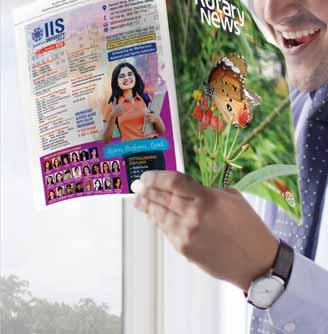




















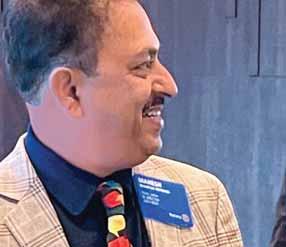

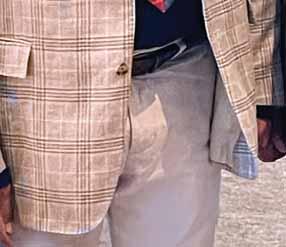

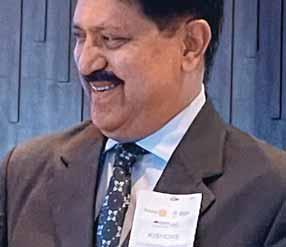
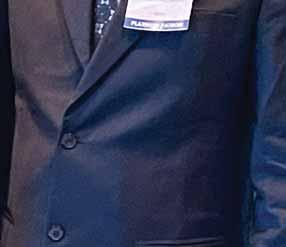

12
Mega projects dazzle Vizag delegates
16
Gavaskar’s third innings — saving children’s lives
20 India’s transition from a receiving to giving nation is remarkable
24
Pune Rotarians create eco-friendly villages with CSR help
30 Let us pole vault into a new world: Mashelkar
38 Keep the fire going: President Jones
48 A Run to Read
32 Introduce water literacy and community driven water management
50 Rotarians have the power to change lives
62
Shamshad, the first female superstar of playback singing

70 A marathon in Salem against drugs

72 Green resolutions for the New Year

76 Water, elixir of life
, male r of f yback singing g em against druggs een New Year ter, elixir of life
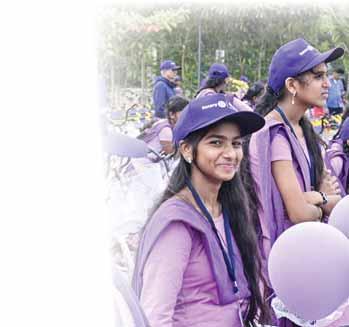

The cover photo of the December issue is unique with buds, flowers and a beautiful butterfly captured in the Kalina Biodiversity Park in Mumbai set up by RC Bombay with help from other Rotarians (such as Rajesh Choudhary from RC Mumbai Varsova). Glad to read about this park and kudos to all those behind this great initiative.
RI President Jennifer Jones narrates distressing stories of families affected by malaria in Zambia and Rotary’s earnest efforts to make it a malaria-free zone. The Editor’s note explains well the global problems due to climate change and efforts that need to be taken by world leaders to overcome this severe disaster. RID Mahesh Kotbagi rightly says that service is the path to purification and we should try to make it the gift of new year, while RID AS Venkatesh urges Rotarians to wear the Rotary pin as brand ambassadors wherever we go. Foundation Trustee chair Ian
All the articles in the Dec issue are nice and inspirational, but among them, I liked best the article on organ donation awareness. Rtn Anil Srivatsa inspires others because, apart from being a kidney donor himself,

Riseley’s message inspires us to donate liberally to TRF.
It was so good to read that Indian golfers made history by winning the Nation Cup in Morocco. Other articles like
he has driven across 48 countries, to drum up support for this cause. He has launched GOLA (Gift of Life Adventure) to get millions of people from all over the world to sign up for organ donation. Hats-off to Srivatsa, his wife Deepali
We welcome your feedback.Write to the Editor: rotarynews@rosaonline.org; rushbhagat@gmail.com. Mail your project details, along with hi-res photos, to rotarynewsmagazine@gmail.com.
Messages on your club/district projects, information and links on zoom meetings/ webinar should be sent only by e-mail to the Editor at rushbhagat@gmail.com or rotarynewsmagazine@gmail.com.
worth reading. The article, was really interesting. photos and descriptions are excellent. Thanks to Team Rotary News for their excellent work.
Thecover story, , should encourage other clubs and districts to take up such projects in their cities under the focus area of environment. The metaphor ‘lungs of cities,’ initially a slogan for the preservation of urban parks, has become a buzzword now with parks and other green space becoming so necessary for citizens living in polluted cities.
and their children Kavya and Soorya. I wish him and his team best of luck.
Dr Jagdish Vaghasia
RC Surat East – D 3060
TWHATSAPP MESSAGES WILL NOT BE ENTERTAINED. Click on Rotary News Plus on our website www.rotarynewsonline.org to readabout more Rotary projects. and are all
On the cover
A dance performance at the Visakha Vista Rotary Zone Institute.
Picture by: Rasheeda Bhagat
he December issue is quite informative, attractive and useful. I was delighted to read the article on Mukesh, my favourite singer as the piece is interesting and pleasurable. I would like to draw your attention to paragraph 2 on page 63 to inform you that out of the six films mentioned, the last one Jagte Raho had background score by Salil Choudhury, and not Shankar Jaikishan as mentioned. S K Nath
RC Sambalpur – D 3261
Editor: Reader SK Nath is right. Thank you for correcting this error.
Visiting Chennai for business? Looking for a compact meeting hall? Use our air-conditioned Board Room with a seating capacity the Rotary News Trust.


Phone: 044 42145666 e-mail: rotarynews@rosaonline.org
Rotary clubs :36,697
Rotaract clubs :11,412
Interact clubs :19,019
RCCs :12,660
Rotary members: 1,195,863
Rotaract members:199,073
Interact members:437,437
As on December 8, 2022
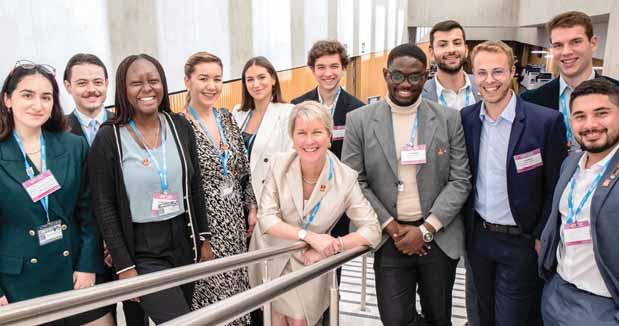
RI
Rotary recently surveyed our members and found something that should be unsurprising but still caused many of us in Rotary leadership to sit up and pay attention: The single most important factor in member satisfaction is the club experience. How at home you feel in your club, how rewarding club meetings are, and how engaged you feel in service projects.
I have seen this firsthand across the Rotary world this year. When members feel an emotional connection to their club, they cannot imagine leaving. And that connection is often forged in “Rotary moments,” when people feel that special connection to the people around them and the impact of their service. Our Imagine Impact Tour is all about shining a light on those Rotary moments and encouraging our members to tell their stories.
But there’s something else that makes an enormous difference in building and sustaining that
connection. It’s the comfort and care of our members — both Rotarians and Rotaractors. As my Rotary friend Todd Jenkins says, “People can’t see how you think, but they sure can see your actions.”
We are in the relationship business, and if we take care of each other — genuinely show concern for each other — then we will make friends for life, and we will do anything to widen that circle of friendship.
The question is: How do we live with our eyes wide open and do the things that really matter? We do this by taking time for each other, actively listening to one another, and treating every Rotary member as equally valuable — no matter how long we have been a member or what position we hold. People like me in Rotary leadership can offer all kinds of advice about how to make your club experience more valuable. But what’s most important is for everyone in every Rotary club to speak up
and listen to one another. We should never be afraid to share with our fellow Rotary member what we expect to get out of our membership and have an open discussion about how to make that happen.
To lead a Rotary club is to invite such dialogue and to be willing to try new approaches. Good leadership is giving it away. Propping others up. Allowing others to feel the victory.
I have one last request for club leaders. We still need to do more worldwide to increase our female membership. It’s up a bit this year, but I know we can and must do better. Rotary is growing again. As I write this, we’re just a handful of members away from surpassing 1.2 million Rotarians again. So let’s redouble our efforts to bolster our clubs with great new members, then keep them for life by providing comfort and care.
Jennifer Jones President Rotary International

ost-pandemic, the meet-and-greet mega meetings of Rotary are picking up steam and this was proved at Visakha Vista, the zone institute held recently in Visakhapatnam, which garnered some 1,000-odd registrations. It was organised under the bold conceptualisation of RI director and convenor Mahesh Kotbagi, and efficient and calm chairmanship of PDG Kishore Kumar, who admitted that the initial hesitancy shown for his home town Vizag as the venue, had even made him think: If it’s not Vizag, then maybe I should step down from heading this event.
But when Kotbagi put his final seal of approval on this city, on the east coast of India, there was no looking back. Every institute seeks to provide a memorable and unforgettable experience to the participants. At the end of the day, the strongest memory from the VV institute was the superb and savvy use of technology. And its endeavour to be an eco-friendly event. As Kotbagi said, with RI now embracing the environment as its seventh area of focus, littering, creation of plastic waste and other garbage was not at all an option. His first priority was to keep the organisers’ eyes firmly on the clean and neat aspect. Plastic banners and posters were done away with, and cloth and other biodegradable or recyclable materials were used. The institute booklet, “which creates a mountain of wastepaper, and which everybody throws away at the end of the institute” was done away with, and the programme was available on the phone app. A fine and novel touch was the beaming of images on huge LED side display panels. Hence, for every topic, the audience enjoyed a plethora of colourful images dancing across the giant panels set along the sides of the auditorium.
As no hotel in Vizag can accommodate 1,000 persons, a clutch of hotels was chosen, and the shuttle service was
so frequent and efficient, that the delegates had little to grumble about when it came to transport. After transport and hotel stay, it is always pet pooja that takes precedence. But even though the weather gods played spoilsport through Cyclone Mandaus and messed up the open air dinners on the lawns and the beach, the food on offer on both the nights was delicious.
But at the end of the day… the little touches and the little moments will stand out. Like the colourful wooden bangles that Kishore Kumar’s wife, Shobha, had organised for the women delegates which became a huge hit, or the free availability of goli soda. And of course President Jennifer Jones’ eyes lighting up when young girls holding lamps walked across the auditorium or when thousands of sewing machines, wheelchairs etc were lined up for the Operation Imagine that she inaugurated.
But for a scribe like me, always on the lookout for a good news copy, it was the waterman of India, Rajendra Singh, who set the hall on fire with some home truths. Sending alarm bells ringing on the fast-depleting water aquifers of India, and admitting that he could only speak plain language without any embellishments, he urged Rotarians to act as the bridge between water activists like him and the governments and “speak up”. Very often, governments were responsible for the damage to the ecology, or excessive usage of water, as is done in Indian agriculture. Simple solutions were available; integrate crop and rain patterns. Instead of contractors, make the communities participants in water management. When you take out profit from agriculture or water management, and “catch every drop of water that comes from the clouds with love, you will learn to use that water with respect,” he said.
Touché!
Rasheeda Bhagat
RID 2981
RID 2982
RID 3000
RID 3011
RID 3012
RID 3020
RID 3030
RID 3040
RID 3053
RID 3054
RID 3060
RID 3070
RID 3080
RID 3090
RID 3100
RID 3110
RID 3120
RID 3131
RID 3132
RID 3141
RID 3142
RID 3150
RID 3160
RID 3170
RID 3181
RID 3182
RID 3190
RID 3201
RID 3203
RID 3204
RID 3211
RID 3212
RID 3231
RID 3232
RID 3240
RID 3250
RID 3261
RID 3262
RID 3291
Selvanathan V Saravanan P
I Jerald
Ashok Kantoor
Dr Lalit Khanna
Bhaskar Ram V
Dr Anand A Jhunjhunuwala
Jinendra Jain
Rajesh Kumar Chura
Dr Balwant S Chirana
Shrikant Balkrishna Indani
Dr Dushyant Choudhary
Kalta VP
Gulbahar Singh Retole
Dinesh Kumar Sharma
Pawan Agarwal
Anil Agarwal
Dr Anil Lalchand Parmar
Rukmesh Pannalalji Jakhotiya
Sandip Agarwalla
Kailash Jethani
Talla Raja Sekhar Reddy
Vommina Naga Satish Babu
Venkatesh H Deshpande
N Prakash Karanth
Dr Jayagowri Hadigal
Jeetendra Aneja
Rajmohan Nair S
B Elangkumaran
VV Pramod Nayanar
K Babumon
Muthu VR
Palani JKN
Dr. Nandakumar N
Kushanava Pabi
Sanjeev Kumar Thakur
Shashank Rastogi
Pravudutta Subudhi
Ajoy Kumar Law
Printed by PT Prabhakar at Rasi Graphics Pvt Ltd, 40, Peters Road, Royapettah, Chennai - 600 014, India, and published byPTPrabhakaronbehalfofRotaryNews Trust from Dugar Towers, 3rd Flr, 34, MarshallsRoad,Egmore,Chennai600008. Editor:RasheedaBhagat.
The views expressed by contributors are not necessarily those of the Editor or Trustees of Rotary News Trust (RNT) or RI. No liability can be accepted for any loss arising from editorial or advertisement content. Contributions are welcome but will be edited. Content can be reproduced with permission and attributedtoRNT.


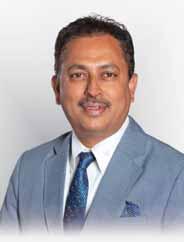
Heartiest congratulations to all of you for a highly meaningful and hugely successful Rotary institute Visakha Vista 2022, held at Vizag and Full Throttle, GETS and GNTS sessions at Abu Dhabi on the Formula One race track, jointly organised with 25 countries comprising Zones 4, 5, 6, 7, 1B, 9 and 10. That was an international experience with idea exchange and borderless love between several countries, teaching us the true meaning of the word ‘international’.
Our eco-friendly and highly technologically advanced institute was attended by over 1,000 delegates and watched online by over 15,000 families. The Operation Imagine service project for 4,000 beneficiaries, Run to Read with 8,000 youth, 400 Rotaractors in the Rotaract seminar, 400 women in Women in Rotary seminar, 400 TRF delegates in major donor recognition seminar, all 41 DGs attending the mid-year review, incoming district trainers and 50 senior leaders and overseas guests from RI, were all responsible for the euphoria and success.
Excellent speakers and luminaries in their fields such as Sunil Gavaskar, Raghunath Mashelkar, SB Mujumdar and Dr Krishna Ella were honoured for their exemplary work in their fields. Film director Subhash Ghai
took us back to old time Bollywood hits and created nostalgia, and told us about the importance of right direction and storytelling.
While the evenings were made entertaining by the Indian Idol talent singer Shanmukh Priya, the day sessions were filled with purposeful speakers such as former Chief Justice of India NV Ramana, Chinmayi Pandya from the Gayatri Parivar, waterman of India Rajendra Singh, Guru Anand from Nepal and Sarah Gautam, who rescued over 30,000 women from the flesh trade and empowered them.
Every event or activity is as good as the people who are behind it. We have been getting rave reviews and feedback from all quarters regarding the meticulous conduct of our event with elan and style. Because of the presence and efforts of dedicated team members like you, we could pull off such a show with elegance and grandeur. So many people called and messaged to express their appreciation and admiration for the manner in which the institute was conducted and the meaningful content it offered.
At the end of day, Visakha Vista turned out to be a value-added Rotary institute.

Kotbagi RI Director, 2021–23



s we enter another year, most of us would probably be thinking of our own resolutions for the New Year. Let us resolve to fully use the power of One this new year. I used to think that one person can do very little and impacting one person doesn’t materially change anything. That was till I was reminded of the origin of the Bhagwad Gita It was a set of teachings delivered by one person to only one person and see the reach of that now!
Doing good in the world doesn’t necessarily have to be a large-scale mega effort. There is much to be said about the power of One. Each one of us has the ability to positively impact at least one person with our words or action or both. Each one of us can choose to be a brand ambassador of Rotary and spread the word about the good our organisation does. One Paul Harris chose to share his ideas with three of his friends and Rotary was born. Each one of us has the ability to demonstrate that to be generous, it is not necessary to have a large wallet. All we need is a large heart. If we look at the list of donors in Rotary, there may be many unlikely names. The names
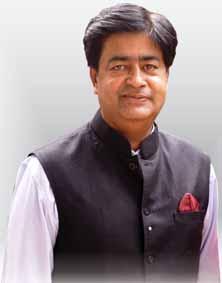
of those who believed they have it in them to make a difference.
All big things have started as the dream of one person. So was our signature polio eradication campaign. We can dream of something that can possibly change the world. It is within the ability of each one of us to do so. Each one of us can look around us and dream of creating those things that would make a fair and an equitable society, that aren’t there currently.
One drop certainly doesn’t make an ocean. But the ocean would certainly be one drop poorer if that drop wasn’t there. I urge every one of you to resolve this new year to unleash the power of one — the power that is within each one of us.
Wish you all a ‘Onederful’ New Year!

Board of Trustees
AS VenkateshRID 3232
Dr Mahesh KotbagiRID 3131
Dr Bharat PandyaRID 3141
Rajendra K SabooRID 3080
Kalyan BanerjeeRID 3060
Shekhar Mehta RID 3291
Panduranga Setty RID 3190
Ashok Mahajan RID 3141
PT Prabhakar RID 3232
Dr Manoj D DesaiRID 3060
C BaskerRID 3000
Kamal SanghviRID 3250
Gulam A VahanvatyRID 3141
Anirudha Roychowdhury RID 3291
TN Subramanian RID 3141
Executive Committee Members (2022–23)
Dr Dushyant ChoudharyRID 3070
Venkatesh H DeshpandeRID 3170
Dr N Nandakumar RID 3232
Dinesh Kumar Sharma RID 3100
Editor
Rasheeda Bhagat
Deputy Editor Jaishree Padmanabhan Administration and Advertisement Manager Vishwanathan K
Rotary News Trust 3rd Floor, Dugar Towers, 34 Marshalls Road, Egmore Chennai 600 008, India. Phone: 044 42145666
rotarynews@rosaonline.org www.rotarynewsonline.org

Anew year is upon us. As we look forward to new beginnings and experiences, let’s think outside the box and find new opportunities to serve through Rotary.

Consider taking up a community economic development project this year. In this Rotary area of focus, we apply our professional experience by promoting the entrepreneurial spirit as we help communities help themselves in a sustainable way. Community economic development projects, to paraphrase the universal adage, don’t just give someone a fish today but teach them to fish so they can eat for a lifetime.
These projects can be microloans to start a livestock breeding business, or they might take the adopt-a-village approach in which Rotary works with communities on multipronged efforts to boost local economies sustainably.
In 2000, during its transition to independence, Timor-Leste was reeling from political violence and destruction. Communities not only needed shelter and improved living conditions but also a new economy.
This is where Australian Rotary clubs stepped up with the East Timor Roofing project to produce and install corrugated roofing, and later, water tanks and grain silos. As the project grew, other organisations joined, including The Rotary Foundation, which delivered a grant that set the project on its path to success.
Before long, East Timor Roofing became a financially viable enterprise, raising enough money to build roofs for homes, schools, orphanages and commercial buildings. Subsistence farmers got silos for their crops. Hundreds of Timorese received professional training in basic building and administrative skills. Thousands of new water tanks ensured that young girls could attend school rather than fetching water.
What began as a roofing project is today a commercial enterprise employing local people and making a huge impact. And your Foundation paved the way. What experiences lie ahead for you in 2023? A district or global grant? Or possibly a visit to Melbourne, Australia, just up the road from my home, to make new friends, reunite with old ones, and find partners for projects during the 2023 Rotary International Convention?
Let’s make a New Year’s resolution to take advantage of opportunities to learn, grow and serve. And let’s have some fun in the process. This is Rotary, after all. So, my friends, let us go forth and carpe annum — seize the year.
Ian HS Riseley Foundation Trustee Chair
Afew weeks back we celebrated Diwali, the festival of lights. As I write this message we are on the cusp of Christmas — the festival of joy. These festivals reflect our work through The Rotary Foundation. Through the programmes of TRF we can bring light and joy into the lives of others and in doing so our own lives light up and become joyful. Our work for and through TRF starts from our own doorsteps and extends to every corner of the world.
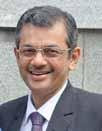
Whether it is equipping a full-fledged five-storeyed hospital dedicated to diabetes care, establishing blood banks, eye banks and skin banks; WASH projects all over the country or setting up a radiotherapy unit; our work through TRF is truly touching lives and transforming communities. But of course TRF depends on us Rotarians to carry on the good work. So each one of us has the responsibility to support TRF.
In November we had training for District Major Gifts and CSR chairs of zones 4, 5, 6 and 7. It was a well arranged, well attended and very usefully structured programme. The participants have gone back charged and I am sure we will see the results in Major Gifts and CSR-India grants in the coming months. Compliments to the EMGAs and the TRF staff at the South Asia Office.
In the Star Wars sequel, The Empire Strikes Back, Yoda, the Jedi teacher tries to teach the hero Luke Skywalker how to fight the ‘force’ that is the greatest power in the universe. Luke replies that he will try. Yoda says, “There is no try, there is either do or not do.” The same is true for The Rotary Foundation. It has to grow and become stronger, nimble, known and respected across the world. And only we Rotarians can ensure that by doing our best for TRF.
The Rotary Foundation has been transforming communities and countries for more than a century. And that is because of the dedication and passion of Rotarians. As the New Year dawns and we gear up to make some resolutions let us resolve to give to TRF every year.
As we Imagine Rotary let us all work to make TRF the foremost agency for doing humanitarian good in our world.
Bharat Pandya TRF Trustee, 2022–26

(in US Dollars)
Total
17,717 46,799 20,179 184,607 184,848 123,240 24,035 32,337 20,092 4,246 88,383 86,686 57,762 8,501 67,986 569,414 7,839 384,872 64,601 1,206,555 156,154 55,534 6,870 77,281 49,485 26,568 22,096 355,044 40,773 4,327 71,428 128,714 99,246 152,348 42,214 20,666 17,153 35,830 48,589 4,611,020 26,913 11,400 5,466 130,539 52,049 4,837,387 625 33,116 0 155,057 108,709 0 1,275 16,105 0 0 62,635 8,967

Wow!” exclaimed RI
President Jennifer Jones, walking up to the sprawling OperationImagine venue of the RI zone institute that was overflowing with thousands of bicycles, sewing machines and wheelchairs. Jones inaugurated the mega service projects where bicycles were distributed to 1,000
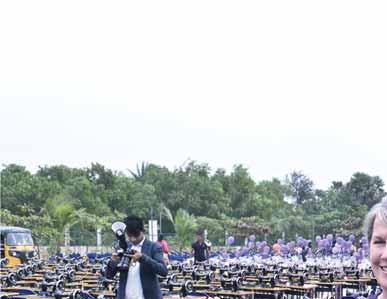
girl students, sewing machines to 1,000 underprivileged women and 1,000 wheelchairs to the disabled in Visakhapatnam.
“An educated girl is an empowered girl. These new bicycles will take you to school where you can focus on your future,” she said, waving to a group of young girls in school uniforms.
To the women, she said, “You all can be economically independent with the income you will now earn from tailoring. It is wonderful to see that Rotary has made all this possible.”
RIPN Stephanie Urchick, RI directors Mahesh Kotbagi, Drew Kessler and Vicki Puliz, TRF trustee Jorge Aufranc, PRIP Shekhar
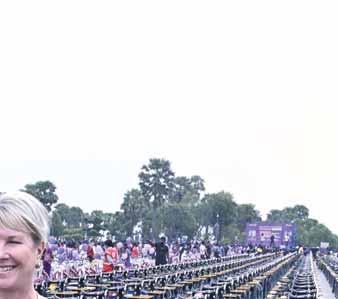
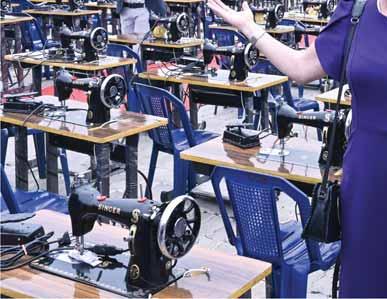
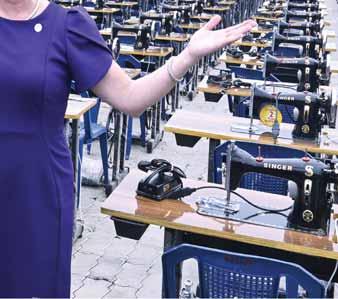
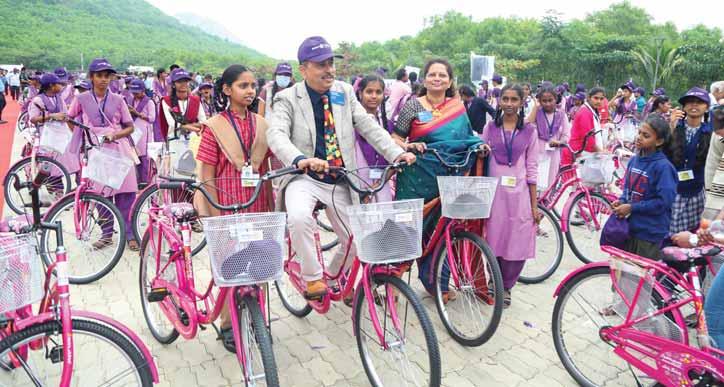

Above: RI Director Mahesh Kotbagi and Amita with schoolchildren.
Below: RI President Jennifer Jones at the Operation Imagine venue.
Mehta, PRID Kamal Sanghvi, RIDE Anirudha Roychowdhury and institute chair Kishore Kumar were present at the event.
The total value of the projects is `2.5 crore, said PDG Lakkaraju Satyanarain, chair, Operation
Imagine. PDG Ravi Vadlamani was the project advisor.
The bicycles and sewing machines were sponsored by RI District 3020. “To encourage participation, we announced that for each bicycle/sewing machine
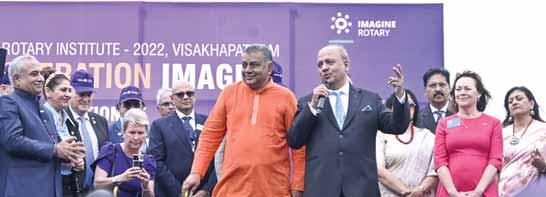



PRIP Shekhar Mehta addressing the beneficiaries in the presence of the programme chair PDG Lakkaraju Satyanarain, TRF Trustee Jorge Aufranc, President Jones, PDG Ravi Vadlamani, Rashi, RI Director Vicki Puliz, institute chair PDG Kishore Kumar and Sonal Sanghvi.

sponsored by a Rotary club, the district will match it with three. Of the 80 Rotary clubs in the district, 49 clubs participated,” said Satyanarain.
Around 1,200 bicycles and 3,190 motorised sewing machines, each costing around `6,000, were
procured. The balance bicycles and sewing machines will be distributed in Vijayawada.

RI District 3020 includes six revenue districts and shortlisting deserving beneficiaries was a huge task, he said, adding, “We decided
Wheelchairs, sewing machines and bicycles lined up for distribution.
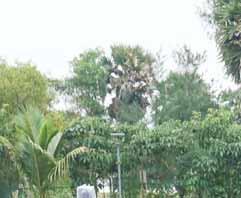
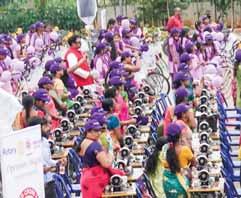
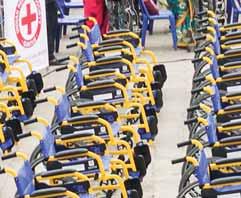

to gift bicycles to girl students studying in Classes 8–10, and sewing machines to women who have not availed benefits from other government schemes. For both the gifts the beneficiaries needed to be from BPL families.” A committee

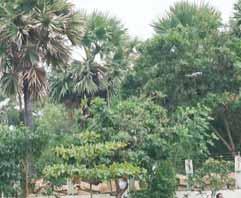
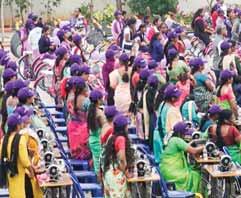

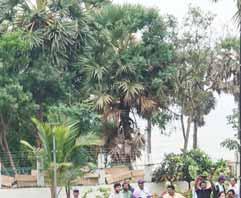
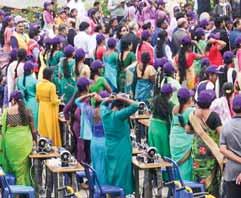





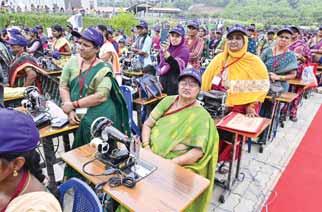
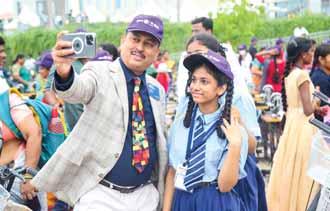
comprising Rotarians screened the application forms.
The wheelchairs were sponsored by the Rotary India Humanity Foundation, said Satyanarain. Of the 1,000 wheelchairs at the institute venue, 500 were given to the Indian Red Cross Society, Vizag chapter; 250 were given to the Indian Railways and another 250 were presented to the PHCs for distribution to deserving disabled people.
You all can be economically independent with the income you will now earn from tailoring. It is wonderful to see that Rotary has made all this possible.
Jennifer Jones President, Rotary International
The smokeless chulhas, sponsored by RID 3030, were given to 500 tribal women to make their kitchen experience comfortable and easier.
DG Bhaskar Ram Vishwanath coordinated the event.

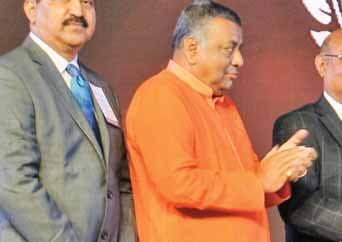
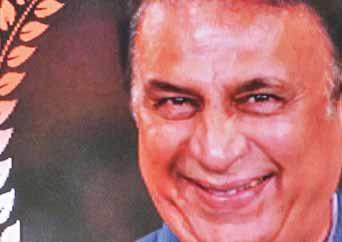

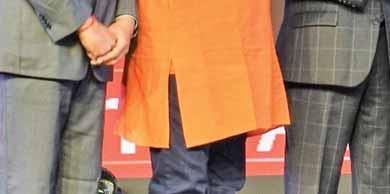
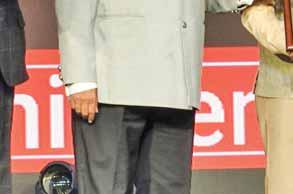

Rasheeda Bhagat

Every human being needs a second chance in life; and more so a child, as the gift of life is really precious. And few could understand the importance of a second chance, as he could, as without a second chance, his career would not have been what it was, said cricketing legend Sunil Gavaskar, while addressing the zone institute Visakha Vista held in Visakhapatnam. A trustee of the Sri Sathya Sai Sanjeevani Hospitals, which operate free of cost on poor children with congenital heart diseases, Gavaskar signed an MoU with Rotary, through
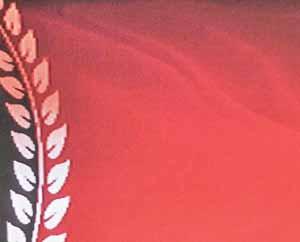
Sunil Gavaskar receives Rotary’s Lifetime Achievement Award from RI President Jennifer Jones, RI Director Mahesh Kotbagi and PRIP Shekhar Mehta in the presence of institute chair PDG Kishore Kumar, PDG Ravi Vadlamani, PRID Kamal Sanghvi and Vivek Gaur, trustee, Sri Sathya Sai Sanjeevani Hospitals.
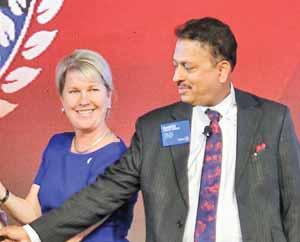
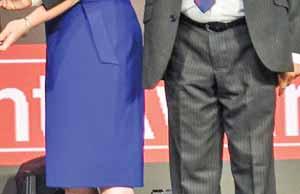
which Rotary has committed `5 crore for conducting 2,025 paediatric heart surgeries at these hospitals till 2025.
Gavaskar was conferred Rotary’s Lifetime Achievement Award, and he received it from RI director Mahesh Kotbagi in the presence of RI President Jennifer Jones and PRIP Shekhar Mehta. He was honoured for “being a sporting legend of our times who epitomised the elegance of the game of cricket on and off the field,” said the citation.
Elaborating on what it means to get a second chance, the cricketer said, “When I made my debut for India in
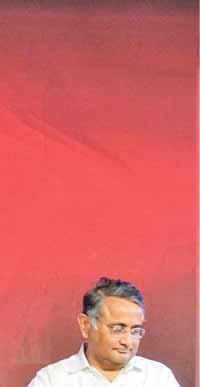
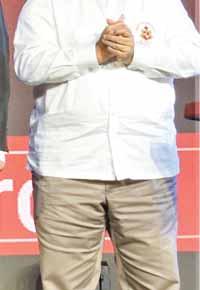
a match with West Indies, I was batting only on 12, when I played a shot and the ball took the outside edge and went to second slip where the greatest of them all, the one and only Gary Sobers, was fielding. And it was, as we in cricketing circles call it, a dolly catch… a sitter, and he dropped it. He dropped it and gave me a second cricketing life. With that second life, I got the second opportunity to continue batting, and I got a half century, and kept my place in the team for the next Test match as well,” he told an audience which lapped up every word of his.
Continued Gavaskar: “When again I was batting on 6, I flashed hard at a delivery from a fast bowler and the ball flew off from the edge of my bat again to Sir Garfield, and this time around it was really a hard catch. It bounced off his chest, before he could see it and again it fell to the earth, and I went on to get my first ever Test century.”
Thereafter, he managed to keep his “place in the team for the next 17 years till I decided I had enough of the game.”
The cricketer explained that he was an ardent devotee of Sri Sathya Baba of Puttaparthi and “apart from being his devotee, this cause resonated with me simply because seeing a child being given another chance at life is extraordinary.” Even more touching was watching the joy of parents when being told by doctors after the surgery that their child would now be healthy. About 99 per cent of the patients coming there were from financially-challenged families and mostly from villages and small cities. “Sometimes they don’t even have the money for a return ticket back home. They come to the hospitals totally bewildered; firstly, they are worried about the child, and then seeing so many people, so many buildings, cars, honking, etc, they are anxious and nervous. When one of our own is sick, we, the world travellers, while waiting for the doctors at the hospital, are so nervous… so just imagine the plight of these parents.”
So once the doctor tells them after the surgery that their child is now going to lead a normal, healthy and long life, “the change of expression on their faces, the relief from anxiety and worry, is something to see. I have seen it and I tell you it has given me more joy than scoring a double century for India.” The surgeries done at these hospitals have a success rate of almost 99.4 per cent; “these hospitals are saving just about every child who comes to them.”
Gavaskar then added: “This then is my third innings in life. I’ve had my first innings as a cricketer, second innings, which is still carrying on but tapering off, which is being, part administrator, part media, doing TV commentary, writing about the game. But this third innings which started a few years back is the most fulfilling, most rewarding.”
Thanking Rotary for helping this passionate cause he added: “Throughout my first innings, I was always looking for the partner with whom I could build the innings for my team, India. I’ve had several partners, almost 19, who opened the innings with me for India. Some were very good, some successful and some played only a couple of Test matches and fell by the wayside. But this partnership with Rotary is something which is going to last and last… together we will save thousands and thousands of children’s lives.”
He added there are four such hospitals now in India, one in Fiji, one in Colombo and many more on the anvil, and they will come up in the next few
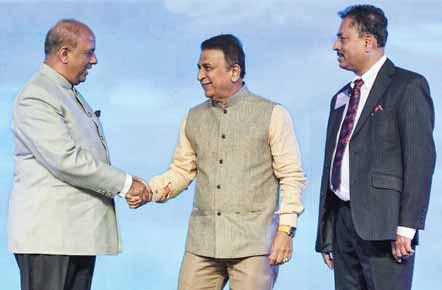
years. “The motto is simple, only dil, no bill!’
Earlier, welcoming the cricketing legend to the institute, convener Mahesh Kotbagi said, “Gavaskar is one of the two big heroes of my life, the other being Amitabh Bachchan, who could not be here.” He said when he had visited one of the Sanjeevani
hospitals, he was struck by the fact that “this was one hospital where there was no billing counter, no insurance claim, nothing… everything is about passion and love.” Hence Rotary had decided to partner with these hospitals under its Gift of Life programme.
Pictures by Rasheeda Bhagat
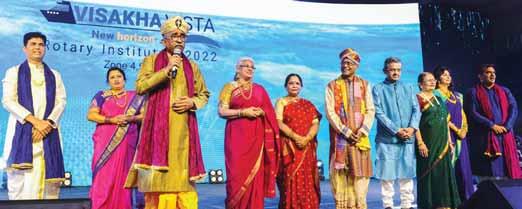
Welcome to Namma Bengaluru,” said RIDE TN Subramanian, the convenor of Rise, the Rotary zone institute for 2023. It is scheduled to be held from Dec 15–17 at the Chamara Vajra
Convention Centre in Bengaluru. The GETS, GNTS and the adjunct seminars will be during Dec 12–14.
RIDE Anirudha Roychowdhury will be the co-convenor. PDG KP Nagesh will be the institute chair and
From L : PDG K P Nagesh, Uma, RIDE T N Subramanian, Vidhya, Shipra, RIDE Anirudha Roychowdhury, TRF Trustee Bharat Pandya, Madhavi, Roopa and PDG Sameer Hariani.
PDG Sameer Hariani, the institute secretary. RI director AS Venkatesh will be the general trainer. PDGs Deepak Purohit and Gurjeet Singh Sekhon will be the GETS and GNTS chairs respectively.

V Muthukumaran
Arobust financial system is in place at the Rotary International to ensure a transparent stewardship of money collected from Rotarians and funds are being well-spent to enhance the participants’ experience, said RI director AS Ventakesh, who is also the RI Board’s treasurer.
Giving a financial overview of Rotary at the zone institute, he said, “budgeting is done five years ahead, with a couple of assumptions on membership growth and per capita dues over this period being factored in.”
Only informed guesses are made for the five-year growth projections as we move
forward and the Council on Legislation, which meets every three years, has decided to raise annual dues by $4 and $3.5 in the next two years, said Venkatesh. The RI Board prepares a wellbalanced budget with revenue and expenses matched, “and it monitors that financial process and ensures that members, clubs and districts are served better.”

RI will continue to invest in programmes, projects and membership support.
AS Venkatesh RI Director
Around two-thirds of revenues are from membership dues, but there is a slight drop in membership in fiscal 2022 (2021–22) compared to what was projected in fiscal 2019, he said. The RI Board has estimated revenues of $93 million in fiscal 2027, up from $74 million (provisional) from fiscal 2023. “RI will continue to invest in programmes, projects and membership support. The Rotary Learning Centre at rotary.org has all the resource material for leadership training and support initiatives for members,” he said.

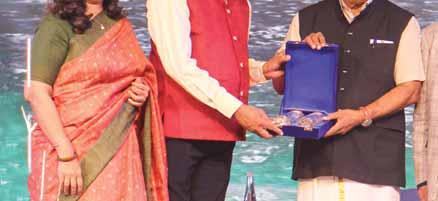
While 57 per cent of revenue is spent on Rotarians and their support programmes, 21 per cent is invested on assets, branding etc, and 22 per cent on administration and compliance expenses as RI has offices in seven countries.
Having 37,000 clubs in 221 countries and territories, Rotary is looking forward to enhance its digital presence and further meet the expectations of its members, he said.

On different occasions, “I was asked by members on how Rotary spends their collected money. Rest assured, we have a financial system so that it is impossible to do anything wrong with your money.”

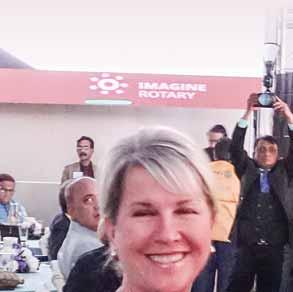

Rasheeda Bhagat
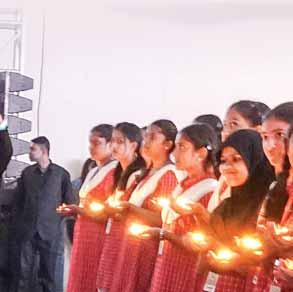
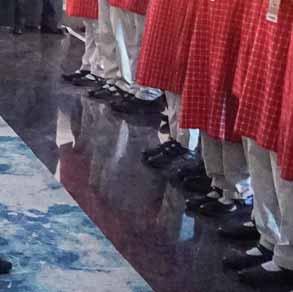


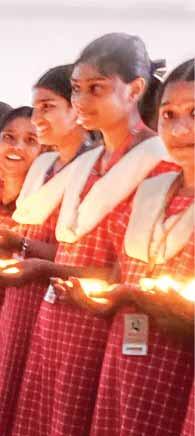
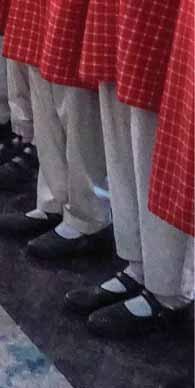

At the inaugural session of the Vizag institute, RI President Jennifer Jones congratulated India’s Rotarians for the “wonderful service projects that you do,” and urged them to share their stories with the rest of the world. Expressing her amazement at the transition of India over the last several years, during which she had made multiple trips to the country, she said the changed India she was seeing at the present was remarkable; “from a receiving nation you have now become a giving nation.”
Explaining the details of her Imagine Impact tour across the world and why she had undertaken it, she said the idea was to turn the spotlight on the amazing service projects that Rotarians do across the globe in Rotary’s seven areas of focus.
One of these pertained to health, particularly to maternal and child health, and eradication of polio continued to be a top priority. “So the first trip I made was to Pakistan in August 2022; I wanted to go there and tell our Rotary stories. I wanted to go to that country, of course, because it is one of our two remaining endemic countries for polio. But also, because I wanted to meet the frontline polio workers to offer to them two very important words — ‘Thank you’. As you know, they put themselves in harm’s way every day they go out into the streets to find the last children who need those two life-saving drops.”
Addressing the 1,000-odd delegates attending the institute, she added, “You in this room know that better than anyone else in the world how important that task is. You’re still immunising hundreds of millions of children every year here. I’ve been here, and done this with you.
We’ve walked together to give these drops to the children. You were the country we thought perhaps would be the last to end polio. But you were able to do that more than a decade ago. You should be immensely proud of that,” she said as the audience burst into a thunderous applause.
Jones said her second trip was to Zambia where RI has undertaken the ‘Malaria-free Zambia’ project. “This was an interesting experience because it is the first Program of Scale, and a test we are doing with our grants.” RI has put in $2 million, with the Gates Foundation and World Vision each putting in $2 million too. With the pot of $6 million, the task was to find 2,500 community health workers, using the same model that RI created in the public health infrastructure for polio. This was “put it into play in Zambia to test if we could eliminate malaria from the country.”
Admitting that these were “lofty goals and a big dream” the RI president said the remarkable result was that in less than one year, when tests were done in the two provinces where this project was launched, it was found “that we have been able to eliminate malaria by 50 per cent in less than one year. This is huge… and based on this success we have to see if we can scale it up to the rest of the country, neighbouring countries and the rest of the world.”
Jones then went on to do what she does best… tell a gripping story. In a village square in one of the provinces of Zambia, she had met Timothy and his 11-year-old son Nathan, who told her about the traumatic time when Nathan had started showing signs of
During my Imagine Impact tour in Pakistan, I wanted to meet the frontline polio workers to offer to them two simple words: Thank you.
malaria. This was before the community health workers identified by this project were put into place. “He put his son on his back, and rode on his two-wheeler for long hours to get him to a clinic for treatment. The child was holding on to his body, and after several hours he could feel his son’s legs go cold, and slowly he began to feel his son go limp on his back. He finally reached the clinic and rushed in screaming ‘help my son’. They were able to give him medicines and save his life.”

But, added a sobbing Timothy: “The same thing happened with my first son. But he didn’t make it; I lost my son… I lost my son.”
Jones said Rotarians should feel lucky that they had the ability to ensure these things don’t happen. “My life is so much better that I got to meet Timothy and Nathan… I know each of you here has similar stories to tell; please tell them.”
She had covered another focus area of Rotary — peace — in Uganda and “next we are going to Taiwan to see the farmers there as they have changed traditional crops to something much easier to harvest. Because in the rural parts many of the men have gone to the cities


and the women have been left to do work that is far too rigorous. We are focusing also on the environment; and then going to Guatemala to see the impact of education and basic literacy projects, and Haiti for water and sanitation.”
project sanitation .”

he nex t
was about me e
Dr M ar k in J o the zo there for a weeka w was he dren. As her she was abo
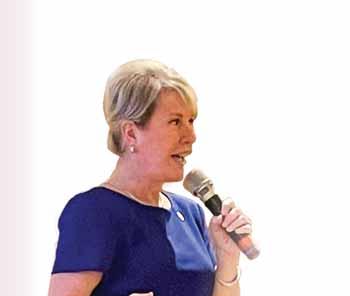

She concluded by saying, “This is what we do, who we are. We create and make miracles and these children, in the course of an hour, literally get the gift of life. Telling our stories is integral to people understanding what is it that we as Rotarians do. We need to paint the face of these kids, along with all the other good work we do.”
Urging people to talk about Rotary to the larger community by telling them that Rotary’s seven area of focus were similar to the UN’s sustainable development goals, which were wellknown, she added: “By telling our stories we need to tell the world that we are more than a club, or a district… we are a movement.”
to a surg “O do that.” So we and seco the room and sto not even wantin
he next story Jones shared was about meeting a heart surgeon Dr Mark in Jordan where she was attending the zone institute. He was there for a week-long mission; she had a detailed chat with him about how he was doing heart surgeries on children. As her trip was ending and she was about to go to the airport she was told Dr Mark was about to begin a surgery and asked if she’d like to watch. “Of course I wanted to do that.” So we raced to the hospital. Very quickly I was in the hospital greens, and seconds later stepped into the room and stood there very quietly, not even wanting to breathe in.”
Dr Mar k did a n on little Selma, and a fr him stitch with h eart a little, s l ittle more. Fi n un it a reall y to the anaesthet warm it u p ’. A li tt le S el ma ’s h I watc h e d h er

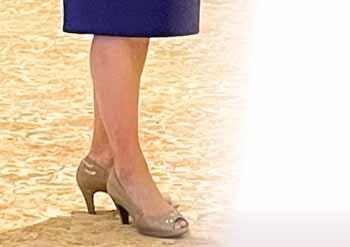
She watched with bated breath as Dr Mark did an open-heart surgery on little Selma, only six months old, and a refugee from Syria. “I watched him stitch with precision, jiggle her heart a little, stitch more…jiggle a little more. Finally he tied a knot, put his hand under the baby’s heart, gave it a really good jiggle, turned to the anaesthetist and said ‘alright, warm it up’. And at that moment little Selma’s heart started to beat. I watched her come back to life… I am a better person because I got to meet baby Selma. Look at how many baby Selmas you have assisted,” Jones said, referring to the previous session where Rotary India had signed an 5 crore with the Sathya Sai Sanjeevani Hospitals trustee Sunil Gavaskar for doing 2,025 free heart surgeries on children by 2025.
At the institute inaugural convenor and RI director Mahesh Kotbagi said the well-crafted three- day event would offer the assembled Rotary leaders a mix of great entertainment and hospitality, excellent speakers who would enhance their knowledge and set them thinking of so many novel ideas, and an opportunity to make new friends and network.
Welcoming the gathering chairman of the institute, PDG Kishore Kumar said immense care had been taken to meet every expectation of the delegates, and a record number of over 1,000 people had registered for the event.
I am a pe meet Selm Selmas you said, to w h ere Rotar y I MoU for `5 cror Ho Gavaskar for do chi
Apart from President Jones, RIPN Stephanie Urchick, PRIP Shekhar Mehta, trustee chair representative and trustee Jorge Aufranc, trustee Bharat Pandya, RI directors AS Venkatesh, Vicki Puliz and Drew Kessler, and RIDEs T N Subramanian and Anirudha Roychowdhury attended the institute.

More institute stories in the next issue
Pictures by Rasheeda Bhagat
Melbourne’s dazzling cityscapes provide the perfect backdrop for capturing photos alongside the new friends you’re sure to make at the 2023 Rotary International Convention May 27–31. You can sightsee at cloud level, gaze at the skyline surrounded by natural beauty, or soak in the sights right around the convention venues. Just don’t forget your camera.
Melbourne Skydeck bills itself as the southern hemisphere’s highest observation point. Take the Eureka Tower elevator to the 88th floor for a 360-degree perspective on city landmarks — from the Arts Centre’s spire to the Melbourne Cricket Ground. Look over Port Phillip Bay, and you can spy distant low mountains, the Dandenongs, when the clouds clear.
At the Shrine of Remembrance war memorial, you get a skyline

The view from inside Melbourne Skydeck.
view from the building’s balcony. At Albert Park, take winding paths lined by exotic and native trees to the lake’s south side for more picturesque downtown horizon sightlines.
Stop outside the Melbourne Convention and Exhibition Centre, the
location for breakout sessions and the House of Friendship, to watch the South Wharf Promenade riverfront bustle, with the photo-ready Polly Woodside tall ship anchored nearby. Inside the building, you’ll feel immersed in Melbourne when you see the downtown skyline and river through huge windows.
You’ll visit Melbourne’s sports precinct for general sessions at Rod Laver Arena, home of the Australian Open. Grab a snap for social media outside against the looming skyscrapers, or pose inside one of the meeting sites in front of a convention favourite: Instagram-worthy Rotary backdrops for selfies with new connections.
Learn more and register at convention.rotary.org.
The request for transfer of Foundation recognition points is processed by the Donor Services team and it takes 5–10 business days to be updated online in the Club Recognition Summary. The report is accessible to club presidents, secretaries and club Foundation chairs through Member Access at www.rotary. org. All members may not have qualified for/achieved PHF recognition status, so we recommend club officers to review the report and let us know if there are any queries.
You may send scanned copy of PHF recognition points transfer request form (in PDF format only) signed by donor to Manju Joshi at Manju.Joshi@rotary.org for processing.
To help us improve services, and encourage a positive culture of communication, send your queries to the following as per your area of concern:
1.Manju Joshi: Manju.Joshi@rotary.org — Recognition i.e, PHF/MPHF/benefactor/transfer forms/spouse linking/consolidation of multiple IDs
2.Madhu Mamgain: Madhu.Mamgain@rotary.org — Major Donor/contribution correction/spouse linking/ consolidation of multiple IDs
To escalate matters, reach out to Ashwini.sharma@ rotary.org.
Directed gifts are not supposed to be given for an intended (yet to be approved) project, though this is widely practised by donors in India. We have had so many situations in the past where donors/sponsors were upset when their grant with a gift that was given for a specific project was determined as ineligible and was declined. However, if the donor would like to pursue it, we do have a pre-review process by the concerned regional grant officer if clubs and districts plan to take gifts for specific projects. The gift should be made only after the application has been pre-reviewed.
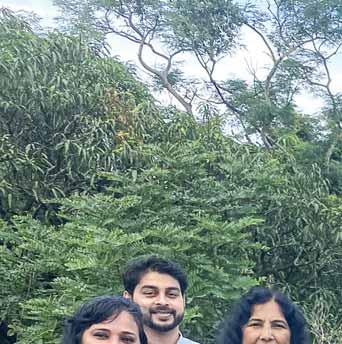
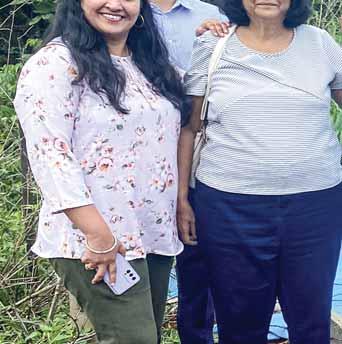
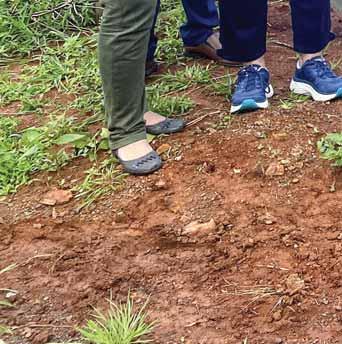
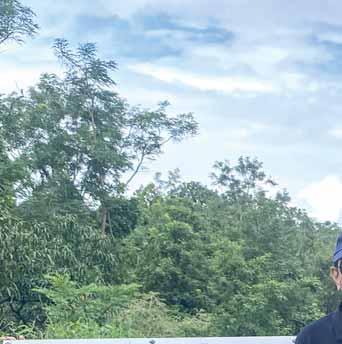
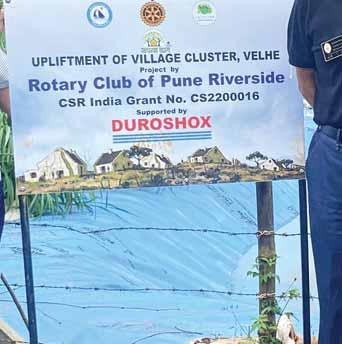
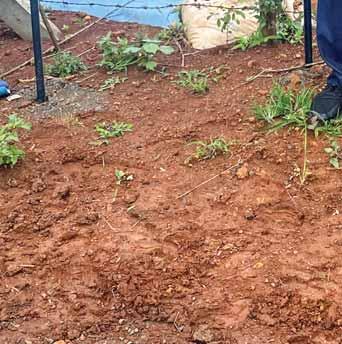

From L: Preethi Nair, Manjeet Varekar, executive, Raintree Foundation, club treasurer Anuradha Mungee, RC Pune Riverside president Ganesh Natarajan, past president Neeru Goel and president-elect Umesh Kumar Jalan on the banks of a farm pond created through rainwater harvesting in a village in Velhe taluk.
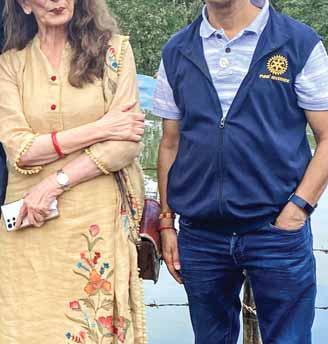
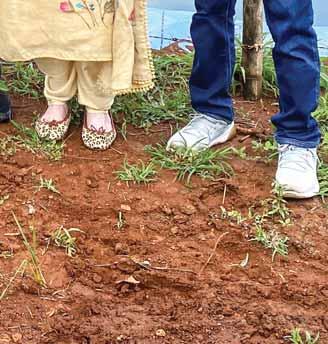

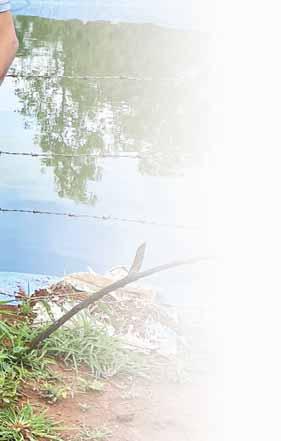
Two Rotary clubs in Pune — RC Pune Karvenagar and RC Pune Riverside — have done a clutch of water and sanitation and income boosting projects in a group of villages in Velhe and Bhor taluks of Pune district.
In July 2019, when Asha Amonkar and Shirish Puranik, the then president and past president of RC Pune Karvenagar, RI District 3131, met the CSR chief of Syngenta, PS Jagadeesha, seeking CSR funding from the company, the latter said he’d come on board provided the service project the club did with these funds would be related to water. This caveat was because the company deals in agri products.

With this condition in mind the club conducted a survey of the remote villages in the Bhor and
Velhe taluks of Pune district, by talking to the village leaders and school teachers.
During the survey, the club realised that the students in the zilla parishad schools in these remote villages did not have access to safe drinking water. All of them carried water bottles to schools, but quite often the water in the container was insufficient to quench their thirst during school hours.
The schools did have water tanks but these stored untreated water from nearby river and streams. This water was unsafe for drinking and resulted in several students falling ill from waterborne diseases, thus affecting their attendance and learning, apart from physical health. The club leaders decided to use the CSR funds to provide a sustainable facility that
a sustainable that would d ensure s f afe d driinking water to the child l ren, year r f afteter r ye yearr.
With a CSR partner available, the club called for quotations, carried out an evaluation of multiple suppliers and testing of water samples to ascertain the quality of water to decide on the correct type of water purifier, and finally zeroed in on the 25 LPH UV water purifier model, normally used in households, says Sachin Amonkar, who is at present the director of IT in the club. It is not an RO unit that is suitable for groundwater, he explains. “In these villages the river water can be accessed and this kind of water purifier is suitable for river water.”
8 ATMs in 9 villages 4,000 people
which would now give their children safe drinking water, “we asked them to contribute funds for the pipeline from the river to the school. It was not big money — just around `4,000. We believe that the participation of villagers is critical for the success of welfare projects as they then feel a sense of ownership with our project. We also involved the village seniors and school teachers in this project.”
Below RC Pune Karvenagar
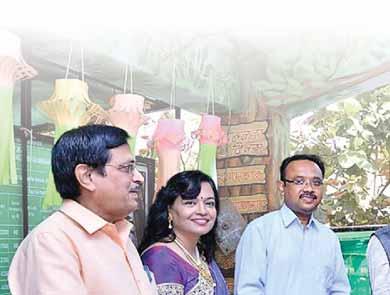
CSR
f funding g of ` f 14 5 .56 6 lakh ensure that the e s had d a st k ake i in n thhe watteer puurififieierrs s
A total number of 52 such purifiers, each costing around `26,000, were installed at 52 schools in villages in both the taluks, with Syngenta contributing CSR 14.56 lakh. To ensure that the villagers had a stake in the water purifiers
Gauri Kulkarni
The result of this water project is that many of the children who trek to schools from their homes in mountainous areas, sometimes a distance of 3–4km, now have adequate safe water to quench their thirst when water from their water bottles runs out. Amonkar explains that in many villages for students living far away from the school there is no transport facility, such as a bus available, and to reach
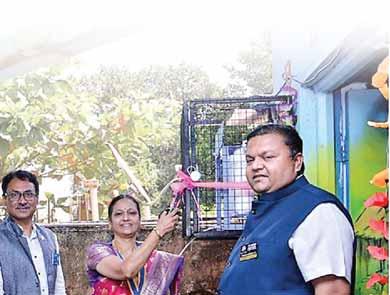
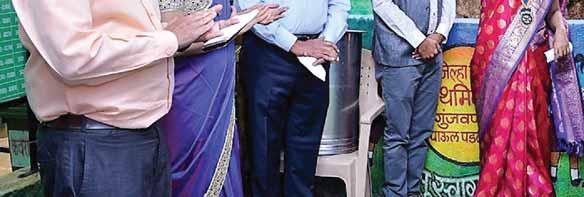
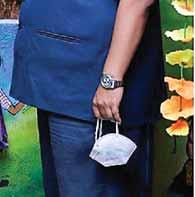
the school, walking is the only option.
On the delay in implementing a project for which discussion had started in 2019, Amonkar, whose wife Asha was the club president that year, says that several times the work on the project was disrupted due to Covid. Both the lockdowns also affected them badly as the schools were closed and neither the staff nor the workers were available.
But despite several uncertainties “we’ve completed the project and the water pumped to the schools from the river/streams is now purified and becomes safe for the children to drink. In all, 2,500 children will benefit from this water purifying project. To ensure sustainability and long-term
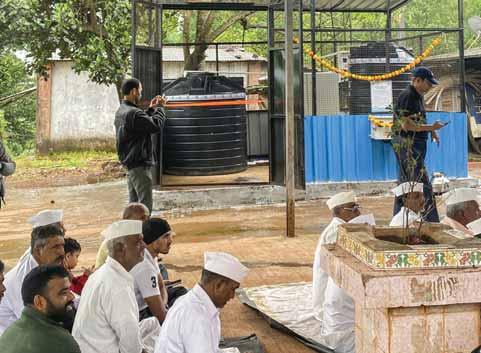
usage of the purifiers, the club has done an AMC with the installers for maintaining these units for two years,” he adds.
The project was inaugurated at the end of 2021 by the then RID 3131 DGND Shital Shah, who complimented the club for

meticulous and detailed planning and persisting with the project despite so many drawbacks brought in by the pandemic. Syngenta CSR head Jagadeesha and club president Gauri Kulkarni were present at the inaugural of the project in the school located in Gunjavane village at the foothills of Fort Rajgad, the capital of Chatrapati Shivaji for almost 25 years.
Said Jagadeesha: “I really appreciate the work undertaken by Rotary for the betterment of communities in the remote villages of our country. Our company would never have known these places, if we had not associated with RC Pune Karvenagar. We would like to continue working with Rotary in the future as well.” Gunjavane school principal Hemant Kamble and the village seniors also expressed their gratitude and thanked the club members for
supporting the school for the past three years.
In another RID 3131 project, a cluster of nine villages in Velhe taluk, about 90km from Pune, is being nurtured by RC Pune Riverside, RI District 3131, which is carrying out eco-friendly village development to provide safe drinking water to the villagers and also augment water for irrigation in these villages.
Explaining the project, Umesh Kumar Jalan, president-elect of the club, says this `52 lakh project is mainly funded by CSR money, with `7 lakh being raised by the district. While surveying these villagers, the club members found
that the water being consumed by some 4,000-odd people in a clutch of nine villages in Velhe taluk is highly contaminated. “Their main source of water is from the river, streams or stored rainwater and we were shocked to find that they do not even filter the water they drink with a cloth, leave alone using candle filters.”
This exposed them all the time to waterborne diseases. So the club members decided to provide water dispensing ATMs in these villages to give the rural people access to safe water for drinking and cooking.
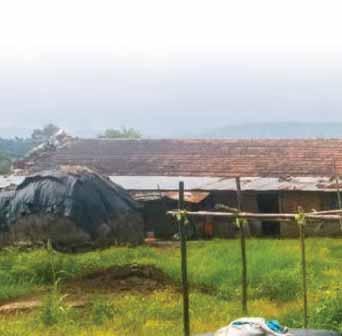
“We set up eight ATMs for nine villages and this eco-friendly project will benefit some 4,000 people,” says Jalan. He explains that in every transaction 20 litres of
safe and filtered water from the ATMs can be drawn by using pre-loaded ATM cards. “They are just like the bank ATM cards and the local panchayat leaders, who have also been given the responsibility of maintaining and running these ATMs, can decide whether to charge `3 or 5 for every withdrawal of 20 litres.”
The ATMs with inlet and outlet water storage tanks, Aqua Plus-make filtration units, with fabricated closed cabins, were installed at centrally located places in the villages.
Below RC Pune Riverside in a village in
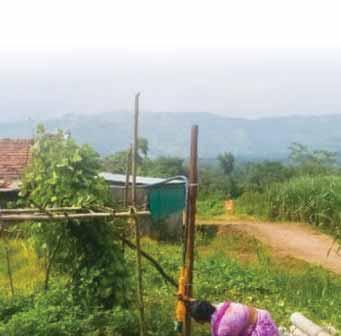
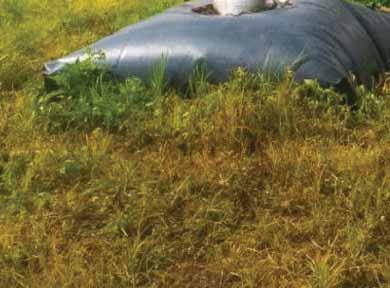
Apart from these ATMs, to help the farmers get regular supply of water for their irrigation needs, the club members have also put up 20 farm ponds through rainwater harvesting. Jalan explains that
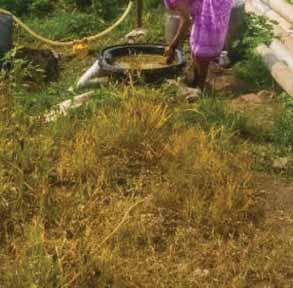

these were made available mainly to marginalised farmers to enable them to plan a second or third crop in a year. The tank’s storage capacity is between 300,000 and 500,000 litres of water. Availability of more water in these ponds have also given these farmers the opportunity to augment their income by rearing fish.
The next sustainable and eco-friendly project was to set up 60 biodigester gas plants which are sustainable and long-term because they can generate gas from cow dung. A biogas plant is a facility that provides oxygen-free conditions where anaerobic digestion can occur.
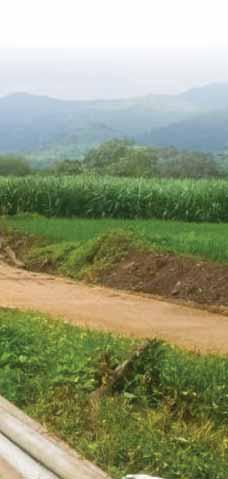

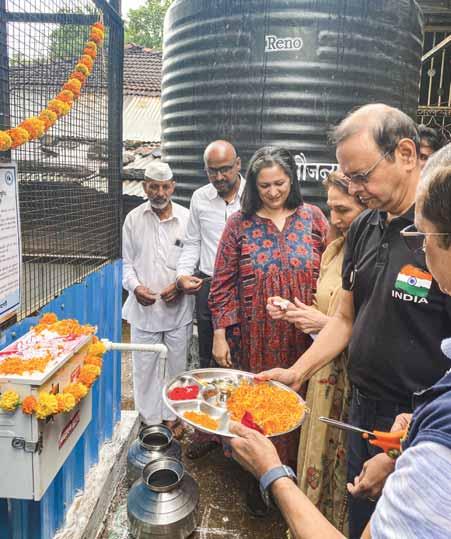
Simply put, it’s an artificial system where you can turn waste into sustainable energy and fertilisers with a positive fallout on the environment. Cooking gas is generated by feeding cow dung and water to biodigester tanks, or pits, which are connected through a gas tube to the gas stove placed in the house. This avoids burning of wood, makes cooking faster, thus saving time. Its main benefit is villagers and their livestock getting a clean, hygienic and eco-friendly environment to live in, adds Jalan.
The bulk of this CSR project costing `52 lakh has been funded by past president of the club Neeru Goel’s own company Duroshox, while `7 lakh has come from the district contribution, said club president Ganesh Natarajan. It was completed in September 2020.
RC Pune Riverside club members are further evaluating the needs of the villagers and the additional support the club can extend to them “so that we can truly develop an eco-friendly village atmosphere.”

V Muthukumaran
India needs to give a quantum push to grassroots innovation in tier-2 cities and villages to leapfrog into a new paradigm in science and technology, that will create a radical, yet sustainable transformation in society, said RA Mashelkar, eminent scientist and pioneer in Gandhian engineering. Speaking at the inaugural of Visakha Vista, the scientist, who is a chemical engineer by profession said, “The country has to switch from the idea of leapfrogging to pole-vaulting so that young scientists, technopreneurs and thought leaders can realise their vision. This radical change will bring in a social revolution with entirely new sets of products and
services for a new world.” Indian scientists must not be just content with best practices, but get into the ‘next practice’. “My experiments in betting on risky ideas have proved that 3Ts — talent, technology and trust — are the key drivers of growth. After the entry of Reliance Jio in mobile telephony, India has jumped from the 155th position to first rank in the mobile data usage over the last few years. The speed and scale of mobile connectivity have reached new heights,” he said.
With the aim to boost local innovators, Reliance Innovation Council (RIC) was set up by Mukesh Ambani, chairman, Reliance Industries, to incubate talent at the grassroots. “Beyonders at the RIC is
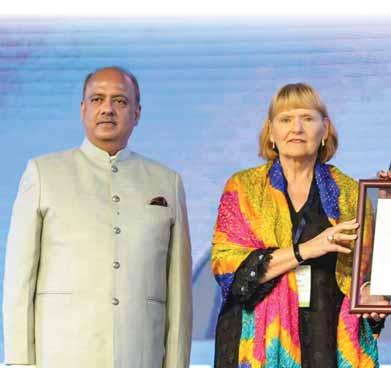
a mentorship programme for budding and young rural talent… people who have original, but path-breaking ideas that can create scalable and sustainable products — this is one such effort at pole-vaulting,” said the former director general of CSIR. Currently heading the New Energy Council of Reliance, Mashelkar said young scientists like Myshkin Ingawale, co-founder, Biosense, and Rahul Rastogi, founder-CEO, Agatsa, have made global headlines with their disruptive, new-age technologies.
Ingawale invented a needle-free, painless haemoglobin test and a smartphone app for urine test, while Rastogi has designed a pocket-size ECG device, Sanket Life, to check the
Scientist R A Mashelkar is presented with the Lifetime Achievement Award by RI President Jennifer Jones and RIPN Stephanie Urchick in the presence of PRIP Shekhar Mehta and RI Director Mahesh Kotbagi.
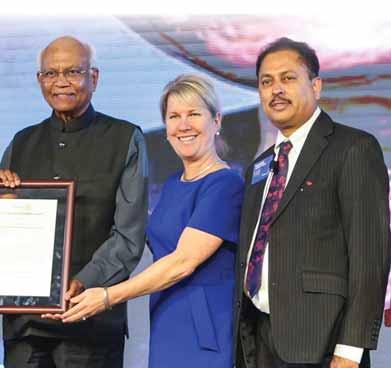
heart and a low-cost, noninvasive screening for breast cancer. “Success is assured in pole-vaulting if the innovation is affordable, scalable, universal (in applications) and resilient. But the risk averse mindset is cynical over radical changes,” he said.
India’s unicorns (startups with market cap of over $1 billion) have great potential to forge a new scientific ecosystem, he said. Born into a poor family in Mashel village, Goa, “getting two meals a day was a challenge then and I studied under streetlights. I was about to quit school, when I got a Tata scholarship of `60 per month to finish my school education.” With purpose and perseverance, “there is no limit to human endurance, imagination and achievements,” he added.
Addressing the institute, Mizoram Governor K Hari Babu said humanity is on the threshold of global elimination of polio and this profound success would not have been possible without the partnership between Rotary and governments that created a synergy for the stakeholders.
“RI is known for its impartial, broad-based approach to build happy communities across the world. It has created a universal template with its 4-Way Test, an epitome of fairness and equity in human interactions.”
Recalling the partnership between the American universities and the US Defence
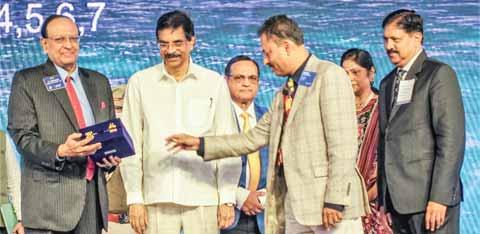
Mizoram Governor K Hari Babu (second from L) being honoured by PRID P T Prabhakar and RI Director Kotbagi as institute chair Kishore Kumar, his spouse Shobha and PDG Ranjan Dhingra look on.
department which funded the high-end academic research that led to the evolution of internet in early1980s, Babu said, “thanks to this collaboration, we now have a wonderful tech tool that benefits humanity in many ways.” Governments need NGOs like Rotary and Red Cross Society to work along with them to ensure the success of their programmes and welfare schemes.
In India there are private charities like Azim Premji Foundation and Ratan Tata Trust that work on multiple fronts taking up many challenges. Recently, Swayam Shikshan Prayog, a collective of women farmers in the Marathwada region working to provide efficient irrigation models and create awareness on water conservation, has bagged the Local Adaptation Champion Award at the COP27 Climate Change talks in Egypt. Another active group, CRY — Child Rights and You — is providing education and healthcare to poor children in partnership with the Union and state governments, he said.
The profound success of polio elimination would not have been possible without the partnership between Rotary and governments.
Holding the Rotary institute in Visakhapatnam will enable the “local government to reach out more effectively to the communities,” said the former MLA and ex-MP from Visakhapatnam. “Also the visit of over 1,000 Rotarians will create a new visibility for us to attract more tourists.”
Earlier introducing the governor, PRID PT Prabhakar said the GoI had joined hands with Rotary in its fight against polio and “the huge success of PolioPlus campaign and awareness projects can be attributed to our collaborative approach.” For optimum results of service projects, “Rotary needs facilitation by the government. After polio, GoI has tied up with us in measles and rubella eradication programmes. Likewise, we can forge partnerships for other healthcare projects like cancer screening and prevention for better reach and impact,” he added.
Pictures by Rasheeda Bhagat

Rasheeda Bhagat
At the Vizag institute, one of the most impressive and outspoken sessions was one dedicated to the memory of the late RI presidential nominee Sushil Gupta, who put water conservation and preservation on the map of Rotary.
the rest of the world. But more dangerous and worrying problem is our overdrawn aquifer. Once your earth has no water, then RBI’s currency will have no value, because only the presence of water can allow our life to continue comfortably.”
Coming down heavily on “our modern education system which puts emphasis on extraction, pollution and encroachment,” Singh said earlier that morning when he had gone to Vizag’s most famous temple for darshan, “I found that the Muni Parvat opposite
Once your earth has no water, then RBI’s currency will have no value; only water can allow our life to continue comfortably.
pl ea “with w inn er wn as worked e m en t ng stas, over
e greaat t m India a t from m
Making an impassioned plea to teach people to use water “with respect,” Magsaysay Award winner Rajendra Singh, popularly known as the waterman of India, who has worked with Rotary on water management projects, gave out some alarming statistics. “According to GoI figures, over 72 per cent of India’s ground aquifer is overdrawn. Rotary has done great work in eradication of polio from India and is still working to eradicate it from
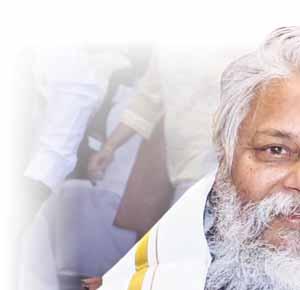
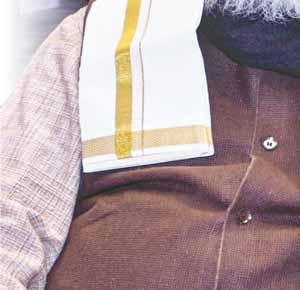

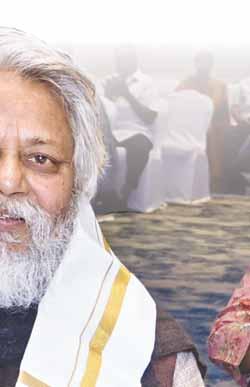
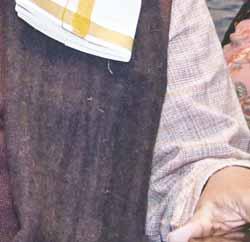
the temple had denuded badly. Now who cut that mountain? The Andhra Pradesh government. Our governments and communities think education should also teach us to destroy nature and its resources; and our technology and engineering teach us how in minimum time we can do maximum extraction from the soil. If such an engineer/extractor gets the biggest package, then our modern education system is flawed.”
Pointing to PRIP Shekhar Mehta in the audience, he said, “Shekhar is very excited and in the next 10 years he wants to build thousands of ponds, check dams, water bodies and our government is also very excited that
in some time it will provide water to everybody. The popular slogan is har ghar me nal har ghar me jal (A tap and water for every house). But these are all empty words because your water bank has no water to realise such promises.”
It was here that Rotary’s role became very important; Rotarians would have to convince the government that “instead of education which concentrates on extraction, let us make it nature-friendly. Unless you change the education system, you won’t be
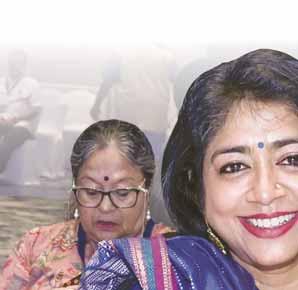
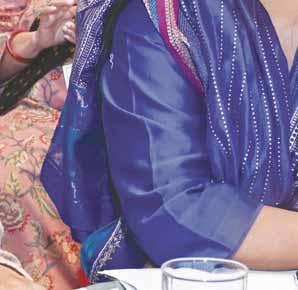


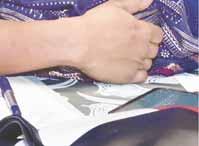
Slogans such as har ghar me nal har ghar me jal , are all empty words because your water bank has no water to realise such promises.
able to stop pollution, extraction or encroachment. The biggest encroacher and exploiter today is the government. If this country needs to be water-rich, we have to think of the good of everybody, and only organisations like Rotary can bring our governments on board and make them see reason.”
Singh’s crucial message to the senior Rotarians at the institute was simple: “Become the much-required bridge; when I talk, I always talk plain language but you can do the right kind of articulation, which I can’t because I’ve never learnt it!”
But Rotarians can explain to the government through proper articulation that whatever money we are spending on reaching water to all citizens, and the dream of jal in every ghar will “fructify only jab hum badal se nikli hui har boond ko apney pyar se pakadna seekh legey (when we learn to catch with love every drop of water coming from the clouds). Once we do that then we will know how to expend that water with respect.”
While talking to the government, organisations like Rotary could make it “understand that only when we implement efficient use of water, however
Amajor problem related to the increasing water scarcity that India faces, ‘waterman of India’ Rajendra Singh said, was the abundant use of water in India for agriculture. “When 80 per cent water is being used in agriculture, when your agriculture becomes your business, then you will spend huge amounts of water only on your farming.”
He added that for the last 15 years “I have been telling our government that India is divided into several geo-ecological climatic
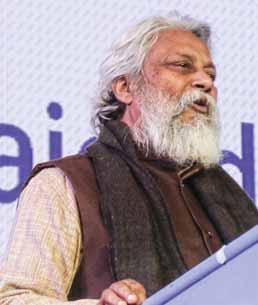
many dams or water bodies we may build, water will never be sufficient.”
After making a plea for decentralised water management, Singh said another crucial requirement was a “water literacy movement. Without that, big water projects won’t succeed, because our cropping patterns are such that they take in huge amounts of water. Also, we are favouring industries that pollute our streams and destroy our water sources. Look at how the Godavari river has been polluted.”
Urging Mehta and Rotary to start a water literacy movement, he said most of the water work will have to be done through small streams. Keep this movement simple and without high sounding words. If this institute can trigger decentralised water conservation and skilful, efficient and thoughtful use of water, “I promise you that as the recently appointed chairman of the World Drought and Flood Commission, for a 10-year term, I will ensure that this world commission will support you.”
As he ended his speech, PRIP Mehta assured him on the spot that “we are planning to do 10,000 watershed
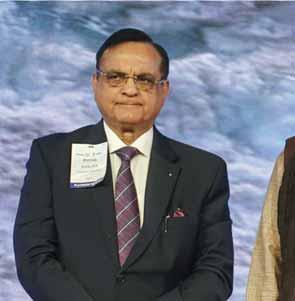
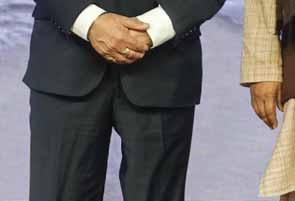
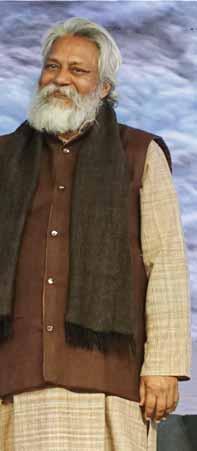

zones, so our hydrological diversity should be respected, and our crop pattern should be integrated to our rain pattern. The day India integrates its agri pattern to our rain pattern, we will be able to save 40 per cent of the water that we are now using in agriculture,” he said.
Striking a note of scepticism, he wondered who would do this work. “No one, because in this work, there is no money, there are no contracts; (governments don’t take up work where huge money isn’t involved!).
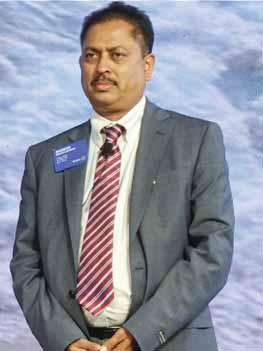

Governments will listen only when strong and influential organisations like Rotary put pressure on it.”
Urging Rotarians to speak up to do good in the country, Singh said: “This is the time to speak up; India’s depleting underground aquifers demand that you speak up.”
He said that in the last eight years he had been to 127 countries and seen how people have been displaced due to various reasons associated with water. There is so much distress in the world today and big displacement of people due to floods and droughts.
“People are forced to move to other countries which are not welcoming them. When Africans go to Europe thanks to such displacement, the Europeans call them climatic refugees.”
Hence tensions rise; the two earlier world wars were vertical ones, but the third world war, warned the Magsaysay awardee, which will be fought due to water, will not be vertical, but a horizontal one and will be fought everywhere; nobody will be spared by this third world war.”
and water rejuvenation programmes and commit to you that all the work will be done only through community participation.”
Addressing the water session, Archana Verma, director of National Water Mission, highlighted the need to conserve water for a sustainable
Jab hum badal se nikli hui har boond ko apney pyar se pakadna seekh legey (when we learn to catch with love every drop coming from the clouds), we’ll know how to expend that water with respect.
ecosystem. Chucking away her prepared speech, she went extempore and said that when the subject is water, the words have to “come from the heart.”
Urging all citizens to use water judiciously, she said that as water is a natural product, “it cannot be conceived or thought of in silos. My only mission is to break the silos in water. To me there is no surface water, groundwater, drinking water. Water is water, but for purposes of policy implementation, we have broken it into silos, and that is where I feel the problem lies because water like human beings cannot exist in silos.”
Her vision as the water mission’s director, was to “break the verticality in the silos” and for that purpose, on Jan 5 and 6, the first-ever meeting of state ministers for water resources will be organised in Bhopal. Here there will be discussion on themes such as water governance, infrastructure, conservation, community participation, etc, which were the main objectives of the Water Mission. They will also discuss the need to integrate water data which could be easily accessed by the public.
Water activist Rajendra Singh left the audience with some difficult questions. “How will a country whose underground water aquifers have been overdrawn by 72 per cent survive? And how can you give the people of such a country false slogans such as ? If you want water to flow into every tap, then first give your ponds some water.”
Once again addressing PRIP Mehta he said: “
. If Rotary wants to do meaningful work, then Rotarians will have to speak up, start
a dialogue with the government and convince it about the absolute need for community driven, decentralised water management, which will work only when water projects are freed from contractors.”
Giving a successful example of such water management that was free from contractors, Singh said that when Devendra Fadnavis became CM of Maharashtra (which faces huge water shortage), “he called me and said ‘now that I’ve become the CM, tell me what should I do about Maharashtra’s water problems.’ So I told him, ‘first of all, stop constructing big dams/water bodies and put up .’ He asked me to lay down the guidelines and ground rules. I said I would do that on the condition that this time the work wouldn’t be done by the contractors but the community.”
His objection to contractors is because “when they do water projects, their only motive is profit, but when the community gets involved,
they worry about all the people getting water. Of course, the community also has corrupt people but by and large they think about common good while doing such work.”
Fadnavis followed his advice and allocated ` 300 crore in the first year to the , and ` 700 crore the next year. But then suddenly a decision was taken that all work above `3 lakh will be done by a contractor, and then corruption came in and the work closed, he said.
But, added Singh, he was aware “that when Rotary undertakes water conservation or augmentation work, it involves the local community. I know what (PDG) Ranjan Dhingra did in Shikar in Rajasthan and when Sushil Gupta was alive, he used to get all water-related work done by the community. When the community takes ownership of such work, corruption takes a back seat.”
Another of their vision was water conservation and “that is where you come in as citizens. We are in the final stages of signing an MoU with the Rotary India Water Conservation Trust headed by PDG Ranjan Dhingra.”
Addressing the session PDG Dhingra paid a tribute to the late RIPN Gupta, and recalled his passion for all issues connected with water conservation and the international conference he had organised in Delhi which was attended by the then President of India APJ Abdul Kalam. “Gupta put water on RI agenda and set up the Rotary India Water Conservation Trust, which has since then put up over 500 check dams and other watershed structures for the social and economic uplift of
Governments will listen only when strong and influential organisations like Rotary put pressure on it. This is the time for your Rotarians to speak up; India’s depleting underground aquifers demand that you speak up.
villagers in UP, Haryana Maharashtra, Rajasthan and some other states. He was responsible for the comprehensive and holistic programme for water awareness, conservation, efficient use and rainwater harvesting, which is now under the leadership of PRIP Mehta.”
Now even bigger and bolder targets in the conservation and rejuvenation of water bodies were on the anvil to carry forward the legacy of Gupta. “So devoted was he to the cause of water that even during the last days of his life he asked me to make a presentation on what work we are doing and what we are planning to do in the future,” added Dhingra.
Pictures by Rasheeda Bhagat
With the Covid pandemic making international travel extremely difficult, and the war raging in Ukraine adding problems to mobility, recently Russian Rotary leaders — DG Alexandr, DGE Maria Gaurilieva and DGN Alexi, along with five of their regional directors from the pilot RI District 2223 — underwent training at the Rotary International’s South Asia Office in Delhi, says past RI director from India Manoj Desai.
PRID Desai and PRID Mikael Ahlberg, RI District 2410, as co-chairs, conducted the training, along with PDG Bina Desai, in Delhi. “During the last three years, in-person meeting was not possible for obvious reasons, but the training in all important parameters of Rotary, such as membership, TRF giving and improving the public image of Rotary, was badly required to get optimum results from the district and give Rotary members all necessary experiences to enjoy Rotary. RI staff Laurie and Farah were supportive of
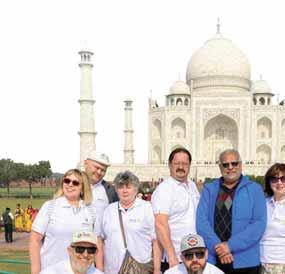
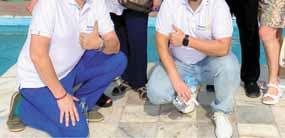
this idea of training the Russians in India and helped to overcome many challenges,” said Desai.
He thanked the RISAO staff in Delhi “under the leadership of Rajeev Ranjan for sparing no efforts to make the training programme both grand, successful and memorable.” The training was conducted from Nov 30 to Dec 2, and certificates were given. “We took them to see the Taj Mahal in Agra and they were really thrilled,” he added.

The delegates were also hosted to a dinner by ICC chair Namrata Suri and a lunch meeting was organised at Agra by PDG Sharat Chandra and DGE Neerav.
Desai added that during this trip, the Russian Rotary leaders learnt about “how Indian Rotary is growing and creating a sizable impact in the community. They are committed to replicate this enthusiasm and put in hard work to get the desired results in all the five regions of Russia, spread over 11 time zones.”


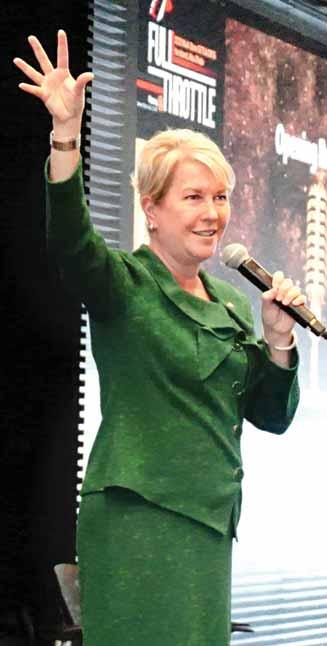
Iam sure you all must be experiencing butterflies in your stomach and are brimming with several ideas and plans to make your term memorable. I too have felt the same on various occasions, including very recently, when I took over as your president. It means that you care, and that you want to do the best. Keep that fire going,” said RI President Jennifer Jones, addressing the DGEs and DGNs at the GETS/GNTS seminar in Abu Dhabi. Her emphasis was on providing comfort and care to the team. “You may think you can do your job well, but if you don’t spend time nurturing, grooming, inspiring and encouraging those who are going to be working with you, you will not be successful,” she said and related how visiting an ailing club member brought joy to them both. When she had recently attended her club meeting, she learnt that one of the club members had suffered a stroke. “I suggested that we should go visit her. But some of them said that it was a long drive and there is so much of traffic. Some said maybe we can call her, or connect with her on Zoom. I visited her and that brought so much joy to both of us. I held her hand and we shed some tears. But at the end of the visit, I could see her calm and happy.”
Reinforcing her message to the incoming district leaders, the RI president said, “Take care of your members. Don’t run away, don’t take the easy step. Take the extra step. Make sure you are there for them because they could be there for you as well. Be the best you can be. We all say that there is no politics in Rotary. But we know that there are too many complaints and too many charges. We need to be better with each other. Try to make Rotary better. Remove the words ‘my year’ from your vernacular, because it is ‘our Rotary’.”
Don’t water the weeds, advised Jones. “You would receive long emails, and they will be negative about everything you do. Instead spend time watering the flowers, nurturing those who want to grow along with you, and you will be an evolved person by the end of your term. I know I am a different person now than I was five months ago.”
Acknowledging the presence of RIPN Stephanie Urchick, Jones remarked that she had not had the chance to formally welcome her as the president-nominee until now. “We have been friends for well over a decade,” she said, and told the DGNs: “You could not be in better hands with Stephanie as your leader when you are serving as governors with her.”

Referring to RI director Drew Kessler, US, who was at the seminar along with his spouse and two children, Jones said, “Including our children, grandchildren and families shows that we all travel this journey in Rotary together. As you plan events in your districts, make sure you take your family along. This way we will have the next generation of leaders.”
Jones urged the delegates to acknowledge and remember the services of the past leaders. “As much as we focus on bringing the younger generation in, we cannot forget the past. We need to celebrate and lift up those who have given us the privilege to be in this room today,” she said.
A PR and communications specialist by profession, she told the incoming district leaders how a good action photograph can impact Rotary’s
image. “We are people of action. We need to show who we are and what we do. Focus your camera on the beneficiaries and their happy faces when you inaugurate a service project in your district. When you do your training sessions take photos of Rotarians engaged in conversation, not their mugshots. People need to see that we are people of purpose and excellence. Do not underestimate the fact that we are gifted with an opportunity to change the world.”
Acknowledging the presence of RI vicepresident Nicki Scott, general secretary John Hewko, and RIDs Mahesh Kotbagi, AS Venkatesh, Muhammad Faiz Kidwai, Vicki Puliz and Kessler, Jones jocularly commented, “nearly 90 per cent of the board is here and I think we can convene a board meeting. If any of you want to change
something in Rotary, we can take care of it here.”
The two-day seminar was a prelude to the Visakha Vista zone institute held at Vizag and was convened jointly by RI directors Kotbagi and Kidwai for the DGEs and DGNs of zones 4,5,6 and 7 (India, Sri Lanka and Nepal) and 1B, 9 and 10 (Pakistan, Indonesia, Bangladesh, Philippines, Taiwan and Hong Kong).
“You can create miracles when you network and learn with an open mind. We have put you on this track to make you lead effectively, set lofty goals and enjoy what you do,” said Kotbagi, adding that the event was significant “as you have the RI president, presidentnominee, RI general secretary and the board of directors here to guide and support you as you get ready to take on the mantle.”
This is the first physical seminar in three
years for the incoming district leaders of zones 1B, 9 and 10. Kidwai urged them to lay greater emphasis on environment projects. “We must now go beyond planting saplings. As Rotary leaders we must lend our voice to influence policymakers to support developing countries facing the grave effects of climate change. I believe that each one of the 1.4 million Rotarians of the world have the power to influence people. Ignite that power.”
PRID Kamal Sanghvi, the general trainer, urged the delegates to “see possibilities where others see a dead end. The world’s needs are more diverse and greater. Making the world equitable and just is a steep mountain climb, yet you have the power to make that happen. Go full throttle as you are the drivers of your district and Rotary.”

Sunny’s autographed bat fetches `45 lakh!
After Sunny Gavaskar had completed his speech, he was requested to take a few balls from Rotarians including RI director Mahesh Kotbagi, and the Little Master gently tapped them towards the audience, the ball of course being a tennis ball.
As the audience burst into raptures seeing Gavaskar wield the willow once again, on a suggestion from RI President Jennifer Jones, PRIP Shekhar Mehta stepped onto the podium and requested the cricketer to autograph the bat which would then be auctioned. The terms: each bid would be in terms of the number of surgeries to be sponsored for children with congenital
heart disease; each operation costing `1.3 lakh. There were a few spirited bids, which began with five surgeries, but the prized bat was taken home by Pawan Agarwal, DG of RI District 3110, pledging to support 35 surgeries (`45.5 lakh).
Gavaskar, clearly overwhelmed by the elaborate introduction, awarding of the citation, Lifetime Achievement Award and other mementoes from senior Rotary leaders, said in a lighter vein: “I came prepared for an overnight stay with a pretty small carry-on bag, but now with all the gifts that you have given me, I feel I should have come with a bigger case. But more than the case and the gifts, I am overwhelmed by the affection and love shown to me and all these
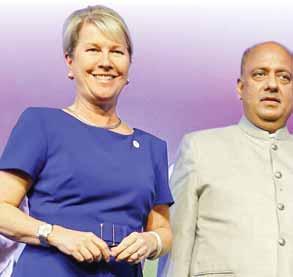
honours conferred on me. Today, you’ve really made me feel very special.”
And this included “the terrific introduction that was given, because generally when I go to an event in India, the host or the MC generally gets away saying ‘Oh, Sunil needs no introduction.’”
An environment-friendly institute
Convenor of Visakha Vista and RI director Mahesh Kotbagi reiterated the need to pay special attention to Rotary’s latest area of focus — conserving the environment. “While planning and executing this institute Kishore (PDG Kishore Kumar) and I, and all the teams, gave special attention to the fact that this event should not create
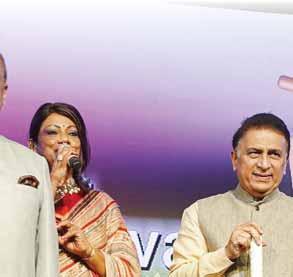
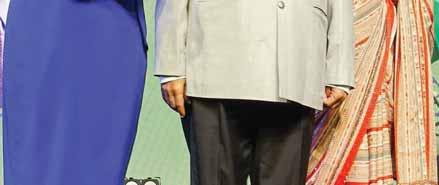

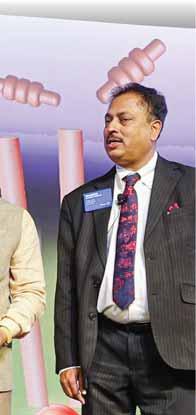

pollution, generate plastic waste etc. So you will find there are no hoardings or (plastic) banners, or plastic flags. Even the name badges were made out of cardboard and banners of cloth. This way, the generation of waste has been kept to a minimum.”
True to the spirit of an environmentally conscious institute, the planning was so thorough that even after the Run to Read event, where nearly 1,000 people participated, the residual litter on the roads through which the runners traversed were quickly cleaned by volunteers and municipal corporation workers. Kotbagi added that no programme booklets, “which go to the trash can after the event, were printed. Everything was available digitally.”
Colourful wooden bangles, goli soda
While the Vizag conference wowed the delegates with smart use of technology and a live band providing an appropriate
musical intervention at the right moment, we noticed the small touches. For instance, institute chair PDG Kishore Kumar’s wife Shobha took care to get colourful wooden bangles crafted by artisans from a nearby village Etikoppaka, and even though tucked away in a corner stall in the exhibition/sales area, these turned out to be very popular for the women delegates. I could hear more than one, including my colleague Jaishree, ask if she could buy some more. “No madam; it’s free but only one per woman,” was the firm reply!
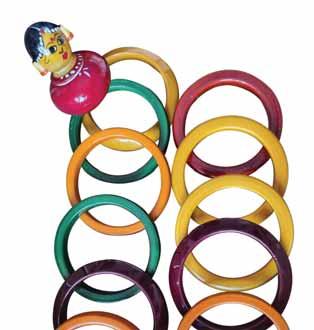

The goli soda available through the institute, was another great touch, and this time it was convenor Kotbagi himself, who needs to be thanked. He later told Rotary News : “When we were growing
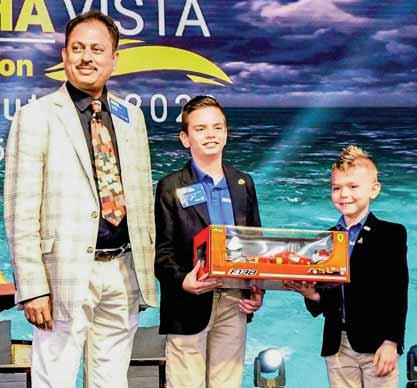
up, the goli soda used to be quite popular, so when I saw it somewhere during one of my visits, I told my team we must include these!” They were a big hit alright, as one could see several delegates walking around with those colourful bottles.
RI director Drew Kessler attended the Vizag institute with his wife and two sons — Jackson and Brandon — and very soon they became the cynosure of all eyes. No delegate would have missed the two well-behaved children, who sat quietly through most of the sessions. One believes they attended more sessions of Visakha Vista than most participants! Director Kotbagi rewarded them by calling them to the stage and presenting them with a model Ferrari, easily the dream car of any young man!

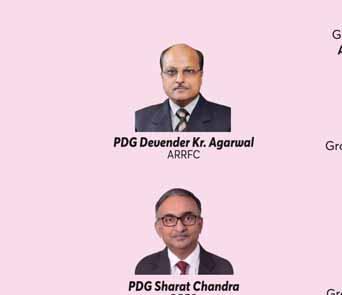
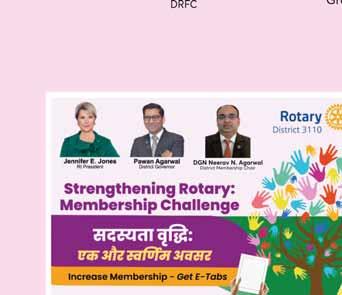
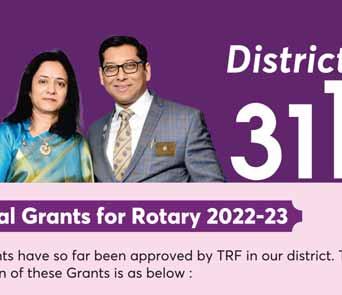
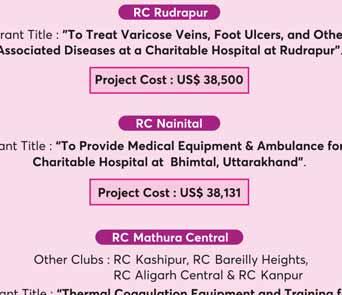
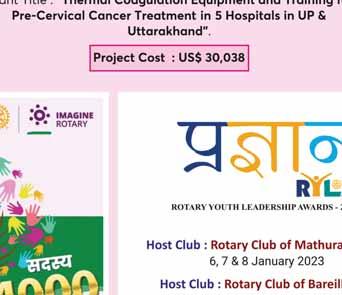


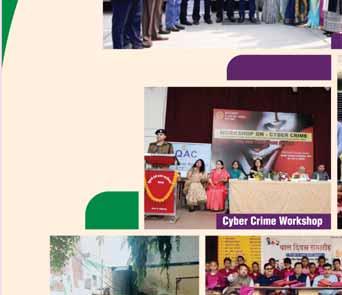
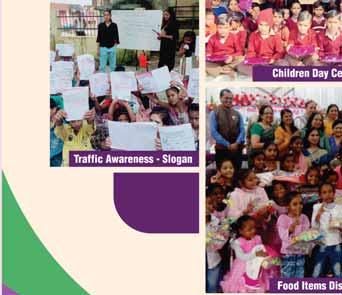

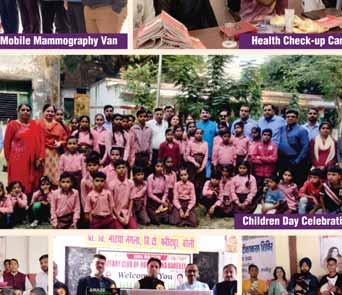
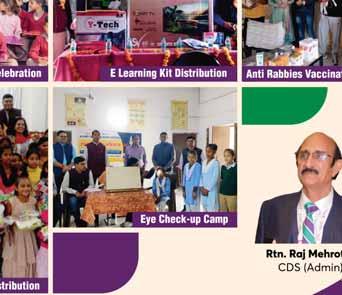


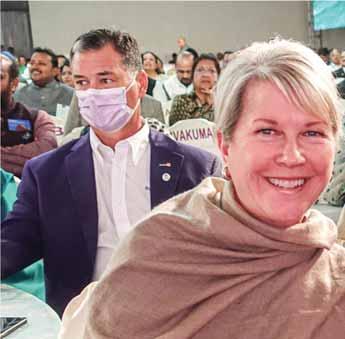
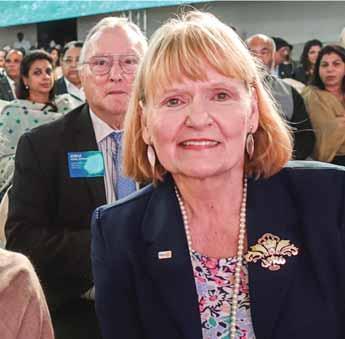


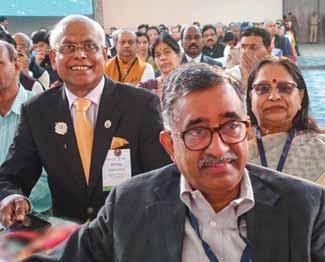


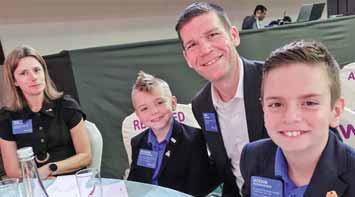


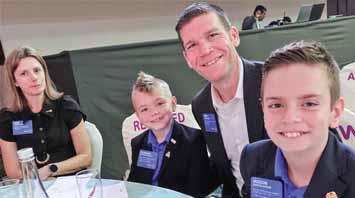
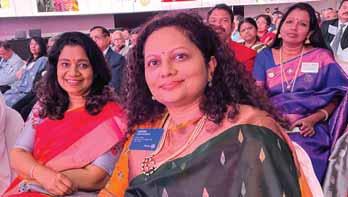


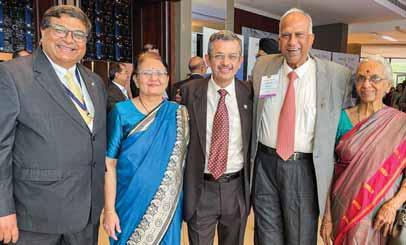

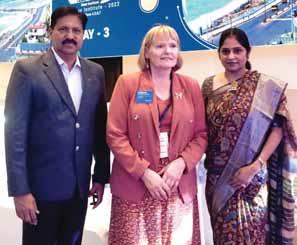

RID Kotbagi and Amita with RRFC Hiroshi Shimuta and Rtr Leonardo from Brazil.

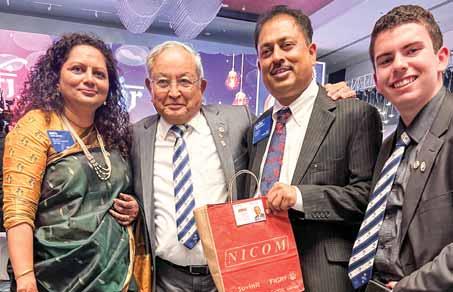


RID Kessler takes a selfie with Amita, RID Kotbagi, TRF trustee Jorge Aufranc, DGN Krayacich, RID Vicki Puliz, RI President Jones and RIPN Stephanie Urchick.
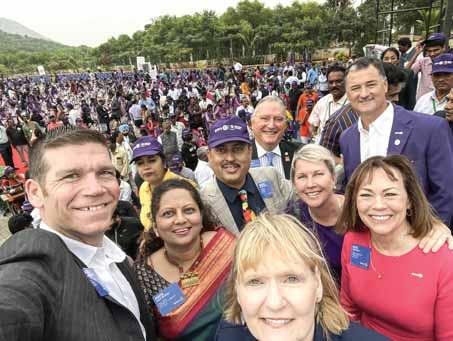
and Amita with PRID Kamal Sanghvi and Sonal.



From L: RID Kotbagi, PRID P T Prabhakar, RID Vicki Puliz, her spouse Timothy, and Nalini Prabhakar.

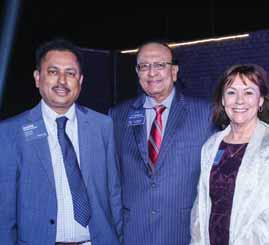
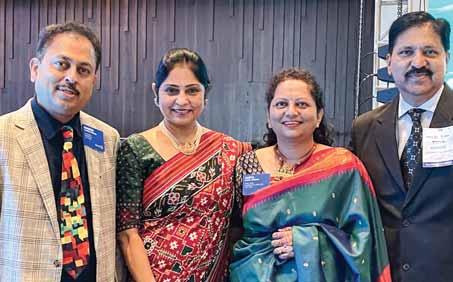


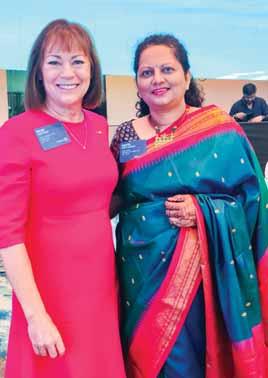

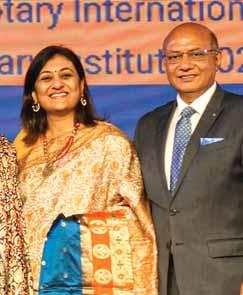
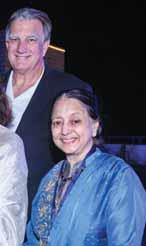
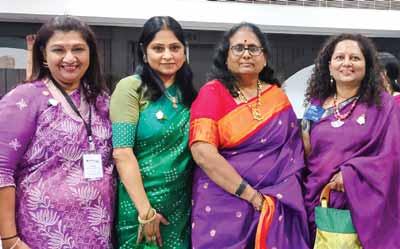
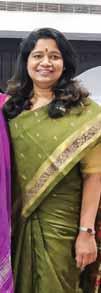



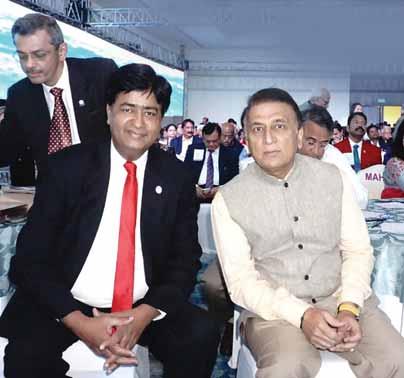
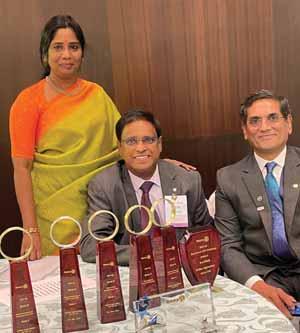


The Run to Read programme was a dream shared by institute convenor RI director Mahesh Kotbagi a few months ago at an institute committee meeting. He said that apart from regular institute programmes “we should do a massive service project and a public image exercise. So we came up with a 5k/10k run — Run to Read project — to raise awareness about total literacy and women’s empowerment,” said PDG G Olivannan. This suggestion was accepted and he was asked to chair the programme.
Institute chairman PDG Kishore Kumar formed a committee with a small group of committed Rotarians from different clubs in Visakhapatnam. RID 3212 DG VR Muthu was the main sponsor.
Their first big challenge was to get the required 5,000 people, the minimum target set by RID Kotbagi, for the event. Strategically bringing in the Indian Navy, Eastern Coast Guard, CISF and academic institutions such as the Andhra University and Gitam University helped the organisers create huge awareness on Run to Read, he said.
Even a month before the event the registration had disappointingly hovered around the two-digit
mark, but this did not lessen the confidence and enthusiasm of the team. As college students in Visakhapatnam started registering, the numbers gradually increased and touched the 8,000 mark, a week ahead of schedule, forcing the organisers to close the registration.
As everyone eagerly awaited the D-Day, the weather in Vizag changed and clouds hovered over the city. As it started raining the earlier day, it gave the organisers many anxious moments. Even on Dec 11, Olivannan and his team watched with dismay the skies opening up, and the rain pouring down till 4.45 am. But undeterred, the organisers
continued with their arrangements. The rain stopped at 5.30 am, but a light drizzle continued.
But, as though by magic, 20 minutes later, the sun was shining brightly and cheerful participants donning green t-shirts started arriving. Soon, over a 1,000 people gathered and Mizoram governor K Haribabu, along with Sivamani Parmesh, additional director general, Indian Coast Guard; PRIP Shekhar Mehta and RID Kotbagi flagged off the event. Institute chair Kishore Kumar and Gautam Rao, pro VC, Gitam University watched the young and energetic RI director Drew Kessler leading the run.
While the guests were about to leave, on the southern end of the road, a huge crowd of more participants surged towards the starting point, and there was another flag off.
Without any hitch, the runners completed the 3km, 5km and 10km runs. Snacks were distributed.
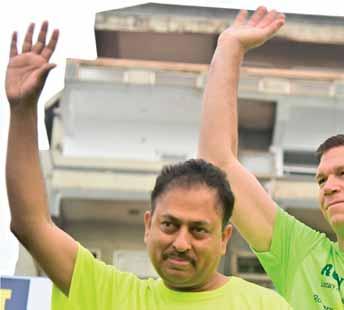


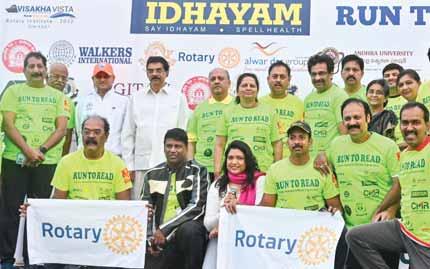
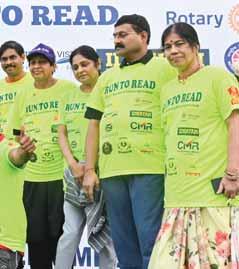
Mehta, Amita, RI Director Mahesh Kotbagi, event chairman PDG
Kishore Kumar at the Run to Read venue.
Thanks to the volunteers and the municipal corporation conservancy workers, the entire stretch was cleared of litter soon after the event ended.
The vibrant team included Rotarians Surekha, Prasad Patnaik, Venkateshwara Kondupudi, Capt Kali Prasad, Jeeja Valsraj, Prameela Jain,
The IFCR — International Fellowship of Cricket-loving
Rotarians — Chennai team led by Captain Viswanath Krishnan won the IFCR Mini World Cup in Dhaka, in which 12 teams from Nepal, Sri Lanka, hosts Bangladesh and India participated. With eight competitive and four festive teams, the tournament held from Nov 14–18 displayed good friendship on and off the field between the contesting teams. Led by Krishnan, the Chennai
team won all their league matches and the finals. Over the years, every IFCRChennai chairman has nurtured fellowship among teammates. The present chairman Jagannathan Maraimalai alias Jagan and his team have taken fellowship to new heights. “Gaurav Jain was the Man of the Series for his consistent performance with both bat and ball in the mini world cup,” said Jagan. Playing his first IFCR tour, Laxman made an impact with his big hitting in all the matches.
and
Ram Babu, GK Murthy, DV Varma, Usha Reddy, Varma Raju, Jose, GP Raju, A Venugopal, Satish, US Sarma and Subhodh.
While a cricket team consists of 11 players, IFCR-Chennai travelled to Dhaka with 20 players and “we gave equal opportunities to all of them.” One of the players, Ram N Ramamurthy, arranged a gala reception for the victorious team at the Chennai airport. DG Nandakumar, RID 3232, felicitated Chennai team chairman Jagan at the IFCR’s standing council meeting at the TNCA Club.
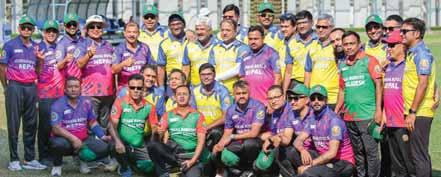

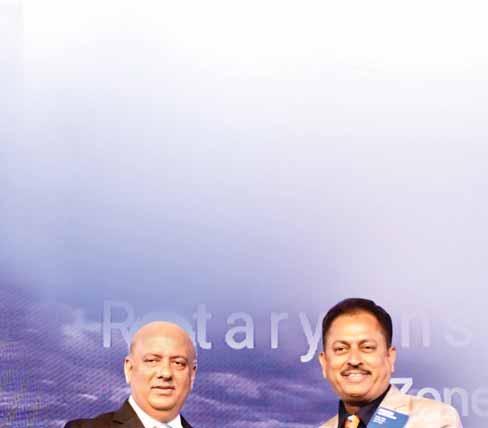
Jaishree
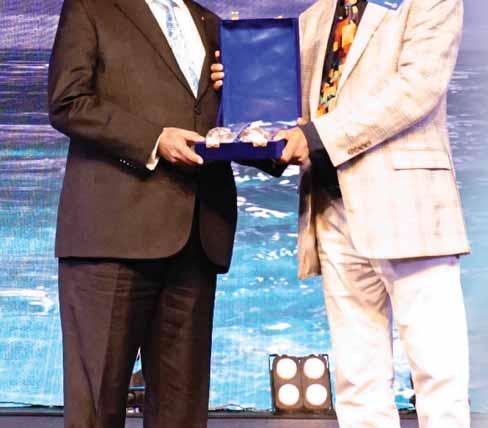
The greatest gift we have been given is the power to touch a life, and together we can transform millions of lives if we set our heart to it,” said PRIP Shekhar Mehta at the Rotary Zone Institute in Visakhapatnam. “No more distribution of pencils, erasers and school bags. It is time we build and rebuild schools, work with the government and make such an impact that the next time the government wants to implement a policy - whether it is water, literacy or health programmes - it invites Rotary for suggestions,” he added.
Commenting on the Operation Imagine event which saw distribution of bicycles to 1,000 girls, 1,000 sewing machines to underprivileged women, 1,000 wheelchairs to the disabled and 1,000 smokeless chulhas to tribal women, he said that he was “happy to note that service is the mainstay of this Institute,” and complimented Institute convenor Mahesh Kotbagi and chair Kishore Kumar for the arrangements and the proceedings.

Mehta noted that this was his first address to a large gathering of Rotarians after completing his presidential term last year, and thanked them “for your cooperation in doing bigger, better service projects in your districts. It was because of you and your district leaders that membership grew in Rotary.” He thanked RI President Jennifer Jones and RIPE Gordon McInally for continuing the Empowering Girls programme during their terms. “In 46 weeks Rashi and I travelled to 42 countries. It gave us so much satisfaction to see the profound impact the programme was creating around the world. Stitching sanitary pads, programmes of self-defence and skilling girls – all the projects were outstanding,” he said.

Institute convenor RID Mahesh Kotbagi honours PRIP Shekhar Mehta with a memento.
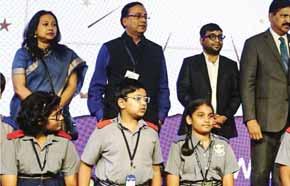
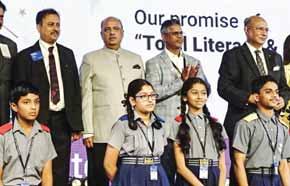

RILM director (programmes) Jhilam Roychowdhury; Biswajit Ghosh, COO, RILM; Abhijeet Mukherjee, associate senior manager, BYJU’s; Institute chair PDG Kishore Kumar; RI Director Kotbagi; PRIP Mehta; GK Murthy, president, RC Greater Visakha; RILM chair PRID Kamal Sanghvi and Ritu Kedia, senior executive, RILM, with the first set of children who received the BYJU’s learning app.
Thank you for your cooperation in doing bigger, better service projects in your districts. It was because of you and your district leaders that membership grew in Rotary.
Shekhar Mehta
Past RI President
As RI president last year Mehta had met 30 Heads of State. “These were not photo opportunities. On behalf of Rotary we made commitment to change lives in various countries.” As a follow up to this, on his recent visit to Ethiopia he met the PM and the President. “I told them to send 100 children suffering from CHD to India and we will perform heart surgeries for them.” The Rotarians of Ethiopia have worked out a partnership with the government and the Ethiopian Airlines to bring the children and their caretakers to India.
The first group of four children has reached Bengaluru for heart surgeries which will be performed in January, he said. “Likewise, we have promised
treatment for 100 Ugandan children and 35 of them have already been successfully treated in Mumbai.” He thanked DG Sandip Agarwalla and PDG Rajendra Agarwal for the service.
“I know how it hurts the entire family if a child is suffering from a heart disease. When a child has a hole in her heart it will pierce a hole in all our hearts. We are people of means and we can afford the treatment. I have met parents whose monthly earning is just `7,000. That means they would have to wait for three years to get a surgery done for their child. But the child may not even live for three months. We are fortunate to be part of Rotary to be able to save the lives of these little children,” said Mehta, adding that Rotary India has completed 25,000 heart surgeries in the past 15 years.
Talking about the literacy programme, he said that Rotary India Literacy Mission (RILM) has a goal to make 10 million adults literate every year in the next five years. “This is in sync with the GoI’s goal. Together we plan to make 100 million adults literate by 2027. Let’s go all out to do that.” He noted that the NCERT was
awardedUNESCO’sKingHamadBin IsaAl-KhalifaPrizeinJulythisyear forthee-learningcontentputtogether byRILMforClasses1–12.
AnMoUwassignedbetween RILMandBYJU’sforthe‘Lakshya Scholarship’whereBYJU’swill provideitslearningapptoonemillion studentsidentifiedbyRotaryclubs. Thescholarshipsworth$1 million(`8 crore)containsdigitalcontentforall boardsfromClass4–12.
HethankedPDGKiranLal ShresthaofNepalfororganising 10,000wheelchairsforIndiaand 5,000forNepal,andcommitting 20,000morewheelchairsforIndia.
HegaveanoverviewofRotary India’slandmarkprojectsthat included50eyehospitals,100,000eye surgeriesand100 medicalvansacross thecountry.“Wewillbedoing10per centoftheGoI’swaterprojectsand thatincludesbuildingcheckdamsand rejuvenatingwaterbodies.Thisyear wewillimplement1,000ofthe10,000 waterprojectsthatwehavecommitted totheGoI;inthenexttwoyearswe willbedoinganother4,000projects, andcompleteourtotalcommitmentby 2027,”saidMehta.
Pictures by Jaishree

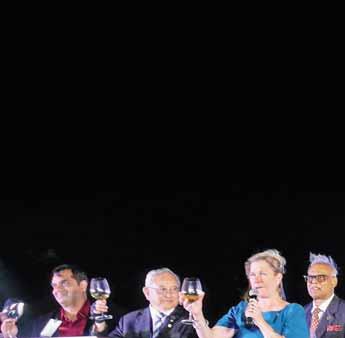
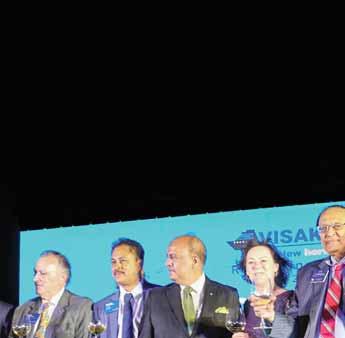


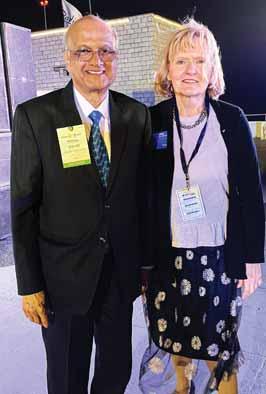
Above:Raising a toast to TRF: (from L) PDG Sameer Hariani, RRFC Hiroshi Shimuta (Brazil), RI President Jennifer Jones, RIDE Anirudha Roychowdhury, TRF trustee Jorge Aufranc, RID Mahesh Kotbagi, PRIP Shekhar Mehta, RI Director Vicki Puliz, PRID PT Prabhakar, TRF trustee Bharat Pandya, PRID Kamal Sanghvi and PDG John Daniel; Left: RIPN Stephanie Urchick with past TRF trustee Gulam Vahanvaty; Below: Amita Kotbagi, President Jones and PRID PT Prabhakar; Right: RI Director Kotbagi and Amita.
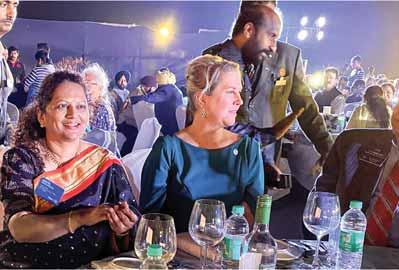

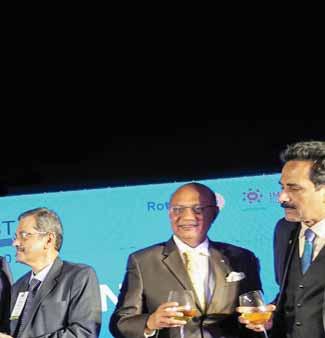
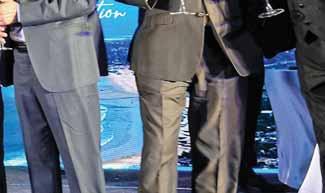
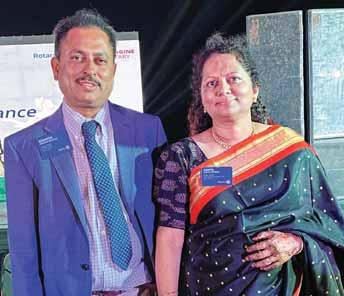

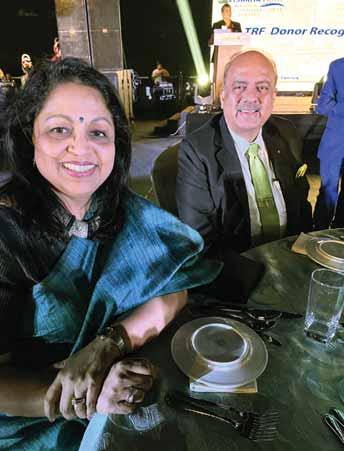
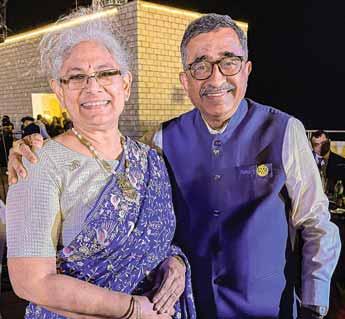


Highest Contribution to Annual FundRajendra K Agarwal (3141)Rajasekhar Srinivasan (3201)
Highest Contribution to Endowment FundRajendra K Agarwal (3141)Sridhar Jagannathan (3232)
Highest Contribution to Polio FundRajendra K Agarwal (3141)Sridhar Jagannathan (3232)
Highest Per Capita APF Contribution to TRFMayuresh P Warke (3142)Rajesh Subash (3204)
Highest Total Contribution to TRF Rajendra K Agarwal (3141)Sridhar Jagannathan (3232)
Highest Donor ParticipationSantosh S Pradhan (3060)Rajesh Subash (3204)
Highest Club ParticipationSantosh S Pradhan (3060) Mayuresh P Warke (3142)
Rajasekhar Srinivasan (3201) Sridhar Jagannathan (3232)
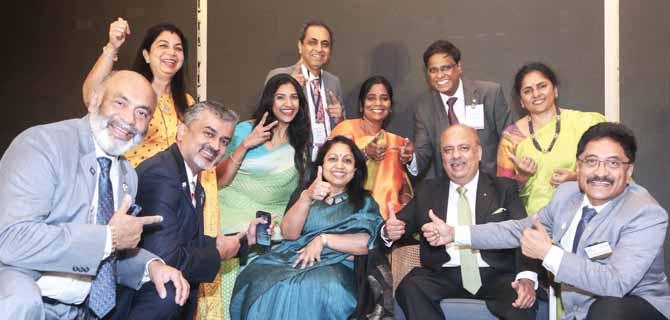
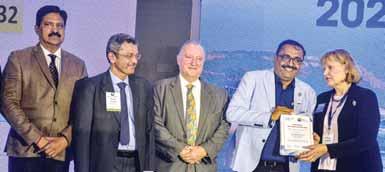

Highest Contribution to Annual FundMohan Shyam Konwar (3240)Pankaj Arun Shah (3131)
Highest Contribution to Endowment FundSantosh Prasad Rijal (3292)Mahmood Fazal (3190)
Highest Contribution to Polio FundSantosh Prasad Rijal (3292)Rama Rao Madipalli (3020)
Highest Per Capita APF Contribution to TRFMohan Shyam Konwar (3240)Pankaj Arun Shah (3131)
Highest Total Contribution to TRF
Santosh Prasad Rijal (3292)Mahmood Fazal (3190)
Highest Donor ParticipationMohan Shyam Konwar (3240)Gaurish Kumar Manohar Dhond (3170)
Highest Club ParticipationMohan Shyam Konwar (3240)Pankaj Arun Shah (3131)
Nitish Laharry Trophy for All India Highest Total Contribution to TRF3141
Binota and Kalyan Banerjee Trophy for All India Highest Endowment Fund Contribution3190
Usha and Raja Saboo Trophy for All India Highest Annual Fund Contribution to TRF3141
Highest All India Polio Fund Contribution to TRF3232
District with highest number of new AKS members3190
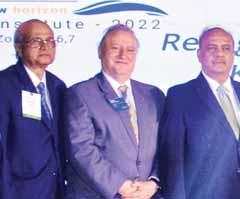
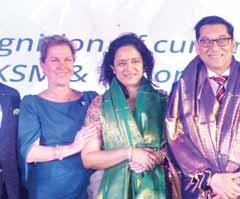
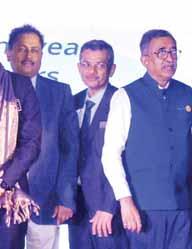
Above: AKS member DG Pawan Agarwal and spouse Prachi being felicitated by (from L) past TRF trustee Gulam Vahanvaty, trustee Jorge Aufranc, PRIP Mehta, RI President Jennifer Jones, RID Mahesh Kotbagi, TRF trustee Bharat Pandya and RIDE TN Subramanian.
Right: (from L) TRF trustee Jorge Aufranc, PDG Rajendra Agarwal (3141), RIPN Stephanie Urchick, PDG Dhond and past TRF trustee Gulam Vahanvaty.
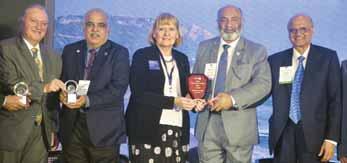
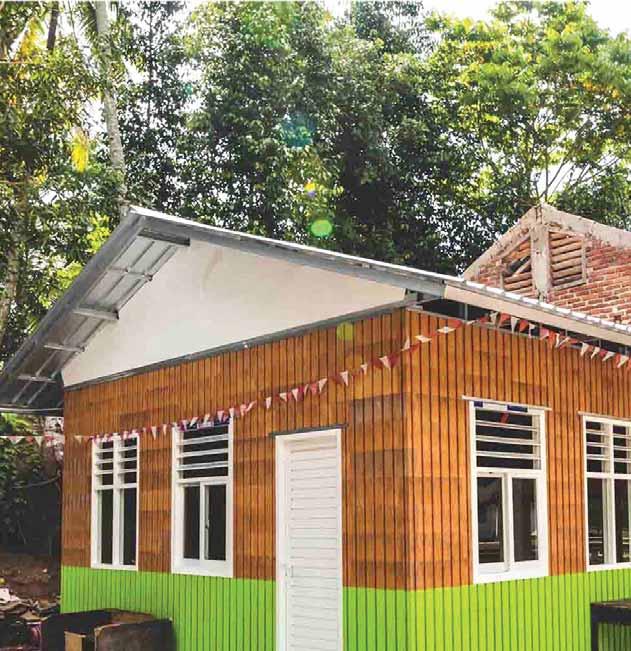
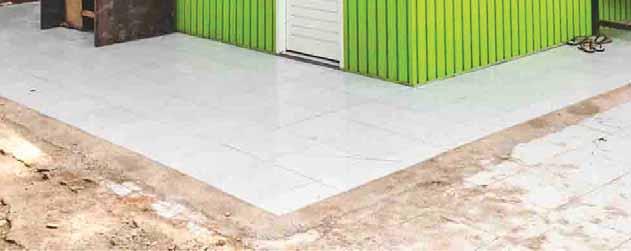

An innovative new technology using recycled plastic blocks is rebuilding schools and homes in earthquake-ravaged Indonesia — and at lightning speed.
When earthquakes devastated villages across the island of Lombok, Indonesia, in 2018, the collapse of homes and school buildings displaced thousands of people and temporarily stopped the education of 4,000 students. The clean-up and restoration efforts have taken years. But an Australian-based charity has found a novel solution to rebuilding destroyed buildings quickly, while also recycling plastic waste along the way.
Classroom of Hope builds sustainable schools and homes that
are safe and secure for communities in developing countries to help students return to their education quicker. Founded in 2012 by Duncan Ward and his wife Nicola Courtin, Classroom of Hope has built 77 schools in Cambodia, Laos, and Myanmar, and is now focused on rebuilding schools in Indonesia.
“50,000 children have had to learn in temporary facilities since the 2018 Lombok earthquakes that destroyed over 400 schools,” said Duncan, CEO of the organisation.
“A child in a temporary school learns half as much as she would in
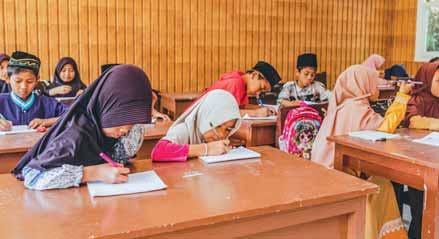
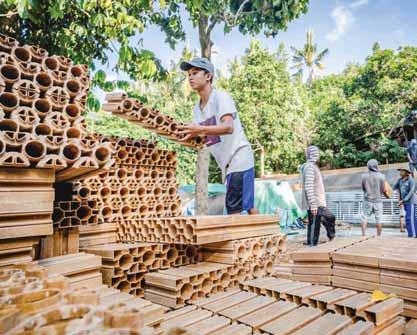
a permanent school, with the loss of learning costing the Lombok economy up to $72 million per year in future productivity.”
When the small village of Taman Sari in Lombok was devastated by the earthquakes in 2018, Classroom of Hope joined the relief effort to help the village build temporary school buildings to get children back into education while a longer-term solution was developed.
That solution came in the form of the revolutionary Block Solutions system, which takes plastic waste and turns it into lightweight, interconnecting blocks that build earthquake-resistant buildings.
Finland-based company Block Solutions uses its recycled plastic block technology for housing projects in Africa and has partnered with Classroom of Hope to bring its Block system to Indonesia.
In 2021, the world’s first Block School was built with concrete foundation, steel rods and U-profiles to reinforce the structure, and a galvanised steel roof, glass windows

The organisation is also building houses using the same Block Solutions system. A home with two bedrooms, kitchen and toilet also takes six days to construct and removes one to three tonnes of plastic waste.
“We are building Block Homes for families who lost their homes in earthquakes and also low-income homes in high poverty areas,” said Duncan.
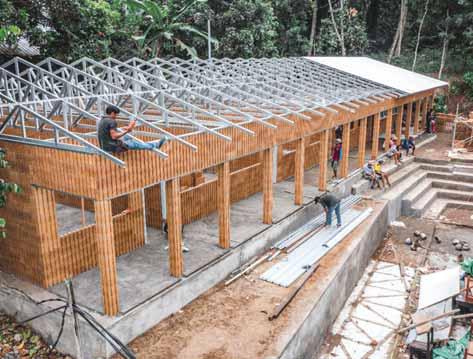
and wooden doors to complete the building.
The 300sqm, five-classroom school building took just six days to construct (a task that would normally take three to six months for a brick and mortar building) and used 15 tonnes of plastic waste in the form of the blocks. The building was completed in June, and students started learning in their new school towards the end of the year when Covid-19 restrictions were lifted.


From top: Construction of classrooms in progress.


“The feedback has been very positive, and the locals have been happy with their new schools.”
The Indonesian government has endorsed the continued construction of Block Schools and Block Homes, and there are also plans to build public toilets, libraries and administration buildings using this technology.
The blocks are currently being shipped to Indonesia from Finland, which adds to the cost and timeframe of each project. However, it’s hoped that the construction of a local factory to produce the blocks in Indonesia will remedy this.
In November last year, a Letter of Intent was signed between Classroom of Hope, Block Solutions, investors, the Government of Nusa Tenggara Barat and representatives from the Australian Consulate and Finnish Embassy to signify a unified approach to building Asia’s first Block Solutions factory in Lombok.
“We have secured impact investment to build Asia Pacific’s first Block Solutions factory. We broke

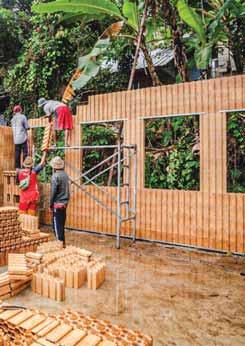

ground in February and hope to get the factory up and running by late 2022, producing blocks from locally sourced materials,” said Duncan.
Once the local factory is established, more schools and homes will be built, with plastic waste being removed directly from the local area to create the blocks.
Currently, 6.8 million tonnes of plastic is generated every year across Indonesia. Almost half of this is burnt, polluting the air with toxic fumes, while significant amounts end up in oceans, harming marine life and polluting coastlines, or being dumped in landfills.
“We intend to build four schools and 10 homes per month using blocks, and the Block Schools programme will build 200 schools serving 35,000 students over fiveand-a-half years,” said Duncan.
“The 200 schools will remove about 3,000 tonnes of recycled plastic waste from the environment. The pipeline of 4,000 homes would serve 24,000 people over 10 years and remove 12,000 tonnes of recycled plastic waste.
“To date, we have built two Block Schools and two Block Homes. Our third school is being completed and we plan to build another three more schools with blocks from Finland to ensure sufficient building contractors are in place when the factory is finished.”
Classroom of Hope is currently seeking donors to fund the final phase of their capacity-building programme, which involves funding and building Block Schools and Block Homes to train many local contractors, and equip them with adequate knowledge in this innovative technology before the factory opens.
“Right now, on an average, a Block School costs about $60,000 and we are raising funds for eight more schools,” adds Duncan.
More information on Classroom of Hope at www.classroomofhope.org
Duncan can be reached at duncan.ward@classroomofhope.org
Reproduced from Rotary Down Under
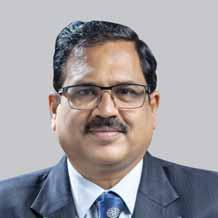
Dr Anil Lalchand Parmar
Consulting doctor
RC New Panvel, RID 3131
Every year this district comprising Pune and surrounding regions of Maharashtra implements service projects worth over `100 crore, and this year, “we are the first district in India to achieve 100 per cent contributions from clubs for Annual Programme Fund amounting to over $300,000, that too in the first three months of the year. We are among the four RI districts in the world to do this,” smiles Dr Anil Parmar.
A mega all-women’s car rally was flagged off with the participation of 88 women Rotarians and 13 volunteers in November. “The rally went through seven districts of zone-7 to spread the message of girls’ empowerment, Say No to Drugs, awareness on cancer detection and prevention, and organ donation,” he explains. He governs 143 clubs having 5,900 Rotarians, and aims to add 1,000 new members and charter 6–7 new clubs. ProjectMamtawill install 113 baby warmers (GG: $59,000) at government and charitable hospitals through 58 clubs. Books are donated to girls’ schools under ProjectAsmita (`5 crore) carried out at 220 places in India with CSR funding from GTPL Hathway and club donations. Tablets with preloaded videos are circulated in schools to create awareness among girls. ProjectDhadkanis holding CPR awareness sessions for the public. “Our clubs will hold more than 1,000 health camps for the rural and urban poor,” he says.
Skilling and job opportunities are being provided at six Rotary districts through a community development project funded by a CSR grant of $225,000. Parmar aims to collect $2 million for TRF. He joined Rotary in 1994 influenced by his late father Lalchand M Parmar.
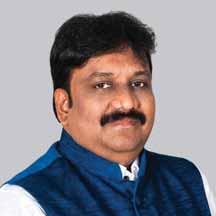
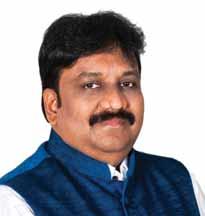
Pravudutta Subudhi
LPG dealer & hotelier
RC Shri Jagannath Dham, RID 3262
Unlikeother NGOs, Rotary is well represented in Odisha and all the 129 clubs are doing public image-building projects in remote areas, says Pravudutta Subudhi. “We will be adding 10–12 clubs, but the focus is on merging clubs with few members with strong ones so that vibrancy is maintained,” he says. He has inducted 206 Rotarians, out of the targeted 400, to take the count to 4,369, and 50 of these will be women.
The Rotary eye hospital at Balasore will be expanded with a GG of $83,000 and 10 eye care centres (GG: `45-50 lakh) will he opened. He plans to set up 100 RO units (`40 lakh) for potable water at rural schools. A Blood Taps App will link blood donors and patients through an e-platform. “RotaryConnects Odisha is a mobile app and directory of club projects. A person or a group can click on it to get help or donations, wheelchairs or medical service,” he explains. Membership cards were given to Rotarians to avail 50 per cent discount at the Apollo Hospitals. On World Heart Day, 22 cardiac camps screened 3,000 people, and 420 were detected with heart defects. Medical camps are held on Sundays in remote areas. Mega cervical and breast cancer detection camps will screen at least 3,000 rural women. Subudhi aims to give $250,000 for TRF. Dr Omkar Hota was chosen as district ambassador to promote Rotary. Inspired by his father, 83-year-old Jaydev Subudhi, he joined Rotaract in 1987 and Rotary in 2002.
V Muthukumaran
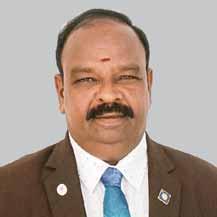
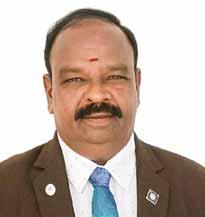
JKN Palani Builder, RC Gudiyatham, RID 3231
Project
Vellichamwill train 25,000 women in tailoring as each club in the district is setting up a vocational centre with five machines at the community halls and panchayat centres. “Already 72 centres are running and 5,300 certificates were issued to sucessful candidates. The certificates from the MSME and MSW departments will help women to get free tailoring machines,” says JK N Palani. In the next 10 years, the tailoring centres will benefit 2.5 lakh women as this is a sustainable model, he says. While the machines (`40 lakh) are donated by Rotarians, the trainers’ monthly salary of `1 lakh is given by the clubs.
A net membership growth of 1,000 will boost the activities of 97 clubs having 3,600 Rotarians. A mammography bus (GG: $170,000) will be flagged off; six ambulances (`51 lakh), funded by PDG Abirami Ramanathan and some clubs, will be available to poor families at a very low cost. A digital x-ray van (GG: $90,000) donated to TB Hospital at Tambaram will visit each club for a two-day TB detection camp; while awareness camps will be held shortly.
On World Girl Child Day, Oct 11, medical camps screened 1.5 lakh girl students and 600 health camps were held in villages. “Our target is to hold 3,000 health camps touching 75,000 lives,” says Palani. He aims to collect $650,000 for TRF. He joined Rotary in 2011 impressed by the work done by the clubs in polio eradication.

V Selvanathan Polymers, RC Pondicherry Cosmos, RID 2981
Skill
Amegaskill development programme at a cost of `1 crore
is being taken up in partnership with the Pondicherry Central University to train 10,000 students of government schools. “We will identify the latent talent of students and hone them so that they can have a bright career. This project is part of Niti Aayog’s programme and we are the execution partners,” says Selvanathan. The clubs will provide career guidance and mentor students towards the next stage of their career growth.
With 135 clubs and 6,850 members, the DG aims at a net growth of 1,000 new Rotarians, of which 873 have been added till now. Two of the targeted 10 new clubs have been chartered already. “We are setting up seven dialysis centres (GG: `2.5 crore), with three machines each, at rural government hospitals, and 10 ultrasound units (GG: `1.25 crore) at rural PHCs,” he says.
Free heart surgeries are done on affected poor children below 12 years. Out of 500 paediatric surgeries, 266 have been completed. Another big project is development of mangrove forests (GG: $40,000) in coastal areas in tie-up with the Annamalai University. Over 1,500 health camps will be held for the poor. “Every week over 30 medical camps offer medicines and treatment,” he says. His target for TRF giving is $1 million. Having joined Rotary in 2003, Selvanathan is elated every time he reaches out to the “poor to make their lives a little bit easier.”
Designed by N Krishnamurthy












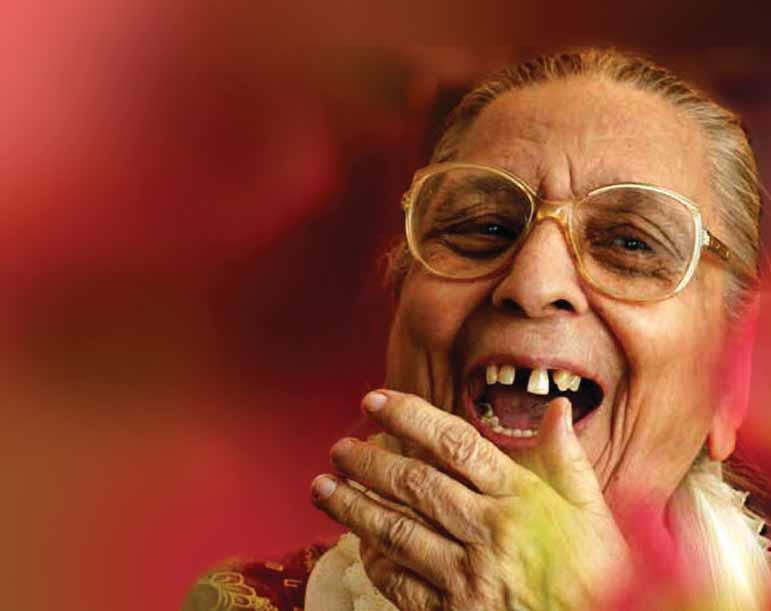





She commanded a fee of `1,000 per song in the1940s, when Lata Mangeshkar charged `50 per song. Her voice — sprightly, expressive and one of freewheeling abandon — had a charisma of its own. It could give any song a twinkle. It was so powerful that the mike had to be kept some distance away! Shamshad Begum captivated music lovers on the radio even before Bollywood’s playback era. She was in fact the first female playback
singer and the first female superstar of Bollywood music.
Shamshad sang a few thousand songs in Hindi, Marathi, Gujarati, Punjabi and Bengali. She stimulated the careers of composers like Naushad, OP Nayyar, C Ramachandra and Madan Mohan. Most Shamshad songs have been adopted into remixes, the most popular being kajra mohabbatwala.
During the 1930s and 40s, Shamshad was the barometer of quality for female singers — they were supposed to sing like her, just as Saigal was a model for male singers. For many years,
she was the brightest star of a constellation that included Noor Jehan, Kanan Devi, Suraiyya, Amirbai Karnataki, Khursheed, Rajkumari and Zohrabai Ambalewali. Her peak period was between 1940 and 1955.
Shamshad was born on April 14, 1919 in Lahore, a day after the bloodshed in Jallianwala Bagh. Her father was a mechanic. She had five brothers and three sisters. Baby Shamshad would sit in front of the horn of the gramophone, listen to the songs and start crooning. Her musical talent impressed her school principal, who got the young girl to lead
morning prayers in school. At 10, she started singing folk-based songs at religious functions and family marriages.
Her uncle Amiruddin told her father that Shamshad’s voice was god’s gift, and she should become a professional singer. But those days women from good families didn’t sing commercially. When Shamshad was 13, Amiruddin took her to meet composer Ghulam Haider, who served Jenaphone Recording Company. He liked her voice and her promise as singer. She signed a contract for a dozen songs at the rate of `12.50 each. Her father agreed to her singing but laid down a diktat: “Only go for singing, don’t get your photographs taken, don’t attend any parties and come home straightaway after the recording.” The daughter once said she followed
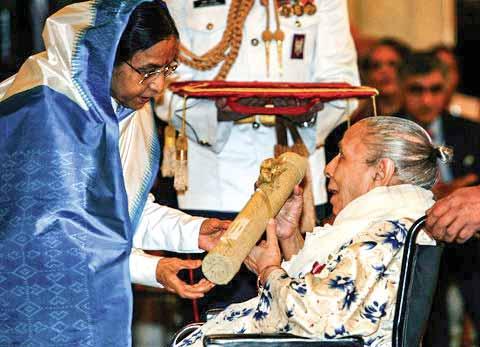
During the 1930s and 40s, Shamshad was the barometer of quality for female singers just as Saigal was a model for male singers.
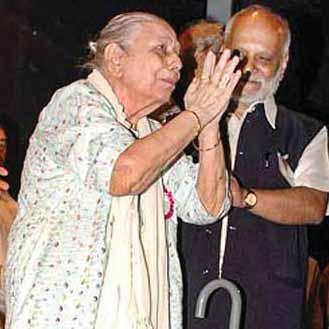
these rules throughout her singing career.
Shamshad got no formal training in music. But Ghulam Haider’s method of training was “hundred times more effective than the formal method and was akin to the polishing of a diamond,” she said.
Shamshad started singing for AIR Lahore and Peshawar from 1937. She sang several hundred devotional and romantic songs and acquired a huge fan following, but unfortunately, none of these songs was recorded, and were lost for posterity. She also sang for a few Punjabi films. A few of them celebrated silver jubilees.
A major landmark in her career was the Hindi film Khazanchi (1941), in which Ghulam Haider created a vibrant music score incorporating the dholak and Punjabi beats. The song Sawan ke nazaren hain was a rage. It was filmed on a feisty gang of young boys and girls cycling and singing. Shamshad’s voice rang out with characteristic insouciance.
























The makers of Khazanchi held a music competition in Pune for those who could sing two songs from the film. The winner? A girl named Lata Mangeshkar! She sang two Shamshad solos from the film.
Shamshad’s career took a leap when Naushad, all praise for the “transparency” in her voice, signed her on for a series of films — Anmol Ghadi (1946), Shah Jehan (1946), Dard (1947), Mela (1948) and Dulari (1949). Shamshad beguiled listeners with the songs Udan khatole pe ud jaoon (Anmol Ghadi), Hum dard ka afsana (Dard) and Dhartiko akash pukare (Mela). She was often Nargis’s voice: the two strengthened each other’s impact.
Naushad showcased the singer’s brilliance and versatility in Babul (1950), one of Bollywood’s most enchanting musicals, He got her to sing as many as eight songs — from the plaintively haunting Duniya badal gayi to the sweetly romantic Milte hi aanken dil hua (both duets with


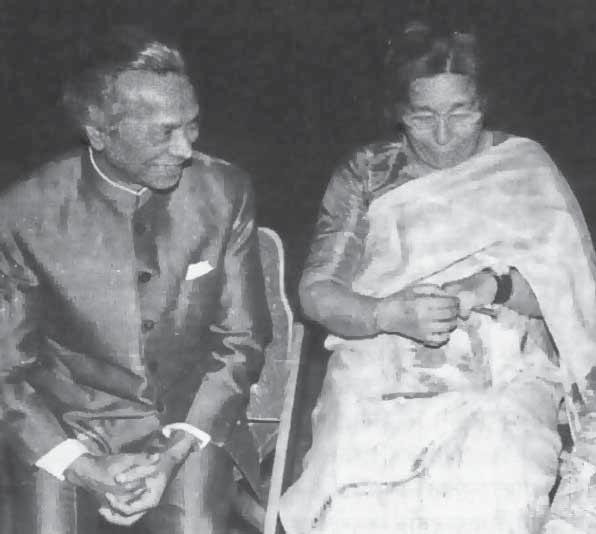
Talat) and the sparkling bridal song Chhod babul ka ghar
With music director Naushad Ali.
But what some critics regard as Shamshad’s best solo, Kahe koyal shor machaye re, was heard earlier in Raj Kapoor’s debut production Aag (1948), for composer Ram Ganguly.
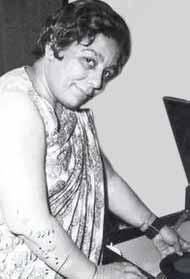
When Shamshad seemed to be at the pinnacle of her career, the Lata cyclone hit the industry in 1949, with Mahal and Barsaat. Composers Shankar-Jaikishen, who revolutionised film music with Barsaat and Awara, adopted Lata as their all-purpose singer.
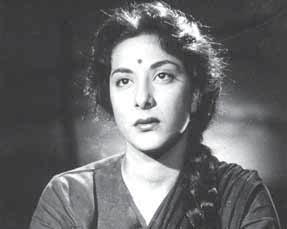

In 1957, Mehboob Khan wanted a full-throated voice for Mother India, and he urged Shamshad to end her seclusion. Result: she sang four splendid songs for Naushad in this magnum opus.
pehla pehla pyar (sung along with Rafi and Asha).
beete rebjaiya (with Rafi, Manna Dey and Asha Bhosle).
Once derided for her “thin voice”, Lata gradually became the gold standard for all composers — including Naushad for whom Shamshad had rendered many hits.
The story goes that Naushad once told Mehboob Khan about the success of his music for Andaaz (produced and directed by Mehboob). It was raining heavily then. Mehboob pointed at the rain and said “It seems as if Barsaat has washed away Andaaz.” Apparently, Barsaat washed away many careers too!
But Shamshad did render some glorious songs in the 1950s and 1960s — for Aan, Deedar, Naghma, CID, Naya Daur, Mother India, Mughal-e-Azam, Kismat etc.
Her voice and style were ideal for OP Nayyar, who specialised in songs of hope, banter, romance and joy. He likened Shamshad’s voice to a temple bell. In CID (1956), an OP Nayyar triumph, Kahin pe nigahen (filmed on a dancing Waheeda) was a typical Shamshad classic. So was the breezy and brilliant Leke
A personal tragedy severely impacted Shamshad’s career: the death in 1955 of her husband Ganpat Lal Batto in a road accident. She had fallen in love with him and married him in 1934 at the age of 15, despite severe opposition from parents on both sides on religious grounds. They were a devoted couple. His sudden death devastated Shamshad. She said she didn’t want to sing any more.
But in 1957, Mehboob Khan wanted a full-throated voice for Mother India, and he urged Shamshad to end her seclusion. Result: she sang four splendid songs for Naushad in this magnum opus: two solos — Holi aaye re aayi and Pi ke ghar aaj pyari dulhaniya chali — and two group songs — O gaadiwale (with Rafi), and Dukh bhare din
Here’s a recap of some of Shamshad’s best songs: Aana meri jaan meri jaan Sunday ke Sunday (Shehnai, 1947): Whistles, mouth organ, rock-and-roll, comedy, raunchy lines — Bollywood’s first westernised song composed by C Ramchandra had it all.
Shamshad sang along with Meena Kapoor, and with Ramchandra himself — in this rollicking hit.
Mere piya gaye Rangoon (Patanga, 1949): A racy romantic song rendered on heroine Nigar
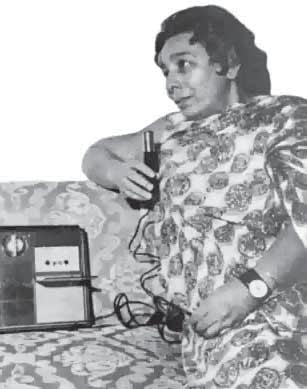























Sultana, who says she looks forward to a telephoon call from her beau in Rangoon. Composer: C Ramachandra.
Milte hi ankhen dil hua (Babul, 1950): Talat and Shamshad delight with their vocals and Naushad weaves his magic, as Dilip on the piano and Munawar Sultana romance each other.
Duniya badal gayi (Babul, 1950): Is the zing in Shamshad’s voice suited only for peppy naughty songs? Listen to Shamshad and Talat in this haunting song of romantic heartbreak.
Saiyan dil mein anare (Bahar, 1951): Heroine Vyjayanthimala sings this melodic gem about her beloved in Shamshad’s vocals — one of the early hits of SD Burman. This song is one of the best-remembered hits of the 1950s.
Bachpan ke dil bula na dena (Deedar, 1952): A tonga-beat song that is the best-loved of all Lata-Shamshad duets. Filmed on two kids played by Tabassum
In 2004, Shamshad read her own obituary. Saira Banu’s grandmother Shamshad Begum, also a singer, passed away, and some newspapers mixed up the two Shamshads!
and Parikshit Sahni. Composer: Naushad.
Hai jaadugar balma (Naghma, 1953): This single song immortalised composer Nashad (not to be confused with Naushad). Like a sweetheart who seems prettier at each visit, this 70-yearold song is more irresistible each time you listen to it!
Leke pehla pehla pyar (CID, 1955): Music lovers have never stopped humming this feisty breezy beach duet rendered with panache by Shamshad and Rafi for OP Nayyar.
Reshmi salwar udta jali ka (Naya Daur, 1957): A scintillating stage dance filmed on Kum Kum and Minoo Mumtaz, rendered by Asha and Shamshad for OP
Nayyar. Cheers and whistles from the audience enhance the joyous abandon of the song.
Teri mehfil mein kismet azmakar humbhi dekhenge (Mughal-e-Azam, 1960): This Lata-Shamshad duet for Naushad is one of Bollywood’s classiest qawwalis, and a feast for ears and eyes.
Kajra mohabbatwala (Kismat, 1968): OP Nayyar pulled Shamshad out of nowhere to render this hilarious duet with Asha Bhosle. It is filmed on Babita (in male garb) and Biswajit (playing a woman). Shamshad sings for Biswajit. She showed she had lost none of her magic.
Shamshad gradually faded away, thanks partly to her reclusiveness and lack of selfpromotion. She never appeared in public and didn’t allow herself to be photographed. In 2004, Shamshad read her own obituary. Saira Banu’s grandmother Shamshad Begum, also a singer, passed away, and some newspapers mixed up the two Shamshads!
In 2009, she was honoured by the Indian government with a Padma Bhushan. The same year, she won the OP Nayyar Memorial Award.
She died in 2013 at the age of 94, in the Mumbai home of her daughter and son-in-law. Lata Mangeshkar said in a rich tribute that she could never match Shamshad’s voice or natural talent.
The author is a senior journalist and a member of the Rotary Club of Madras South

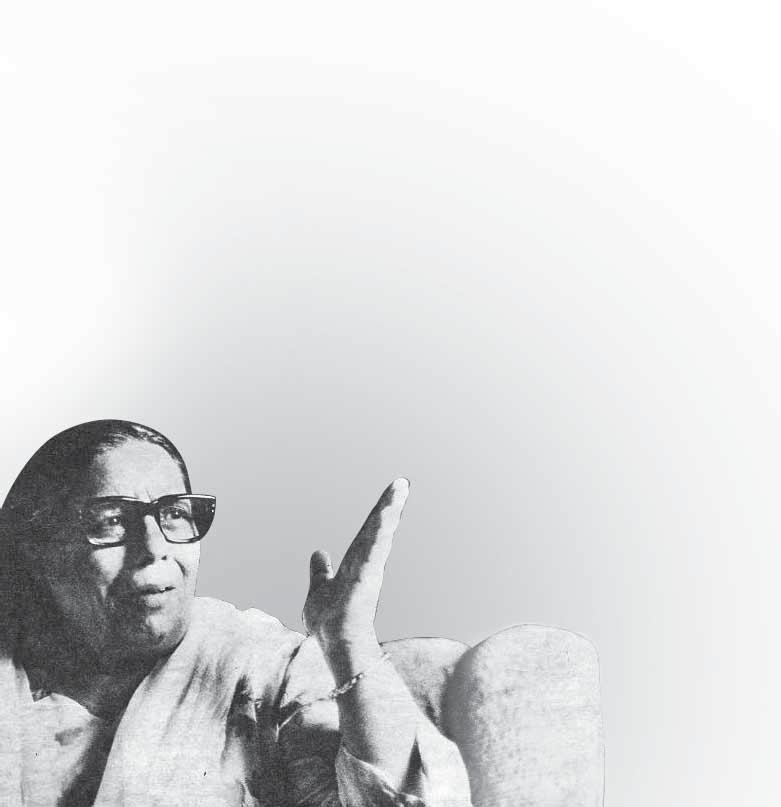
Designed by Krishnapratheesh S

A three-day handicraft exhibition was organised by the Art for a Cause Committee of RID 3291 and RC Ganga Heritage to help local entrepreneurs boost their income. Over 20 stalls were set up mostly by women entrepreneurs at the Noti Binodini Art Gallery, Kolkata.
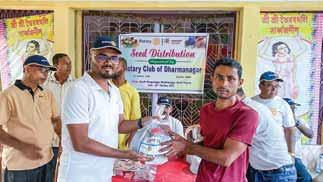
A club member distributes seeds and manure to a farmer.
In a bid to overcome challenges post Covid and boost farmers’ income in Tripura, RC Dharmanagar, RID 3240, in association with the horticulture department, distributed winter vegetable seeds and organic manure among farmers in North Tripura. The club plans to expand this project as part of its post-pandemic economic recovery activity and community development initiative.
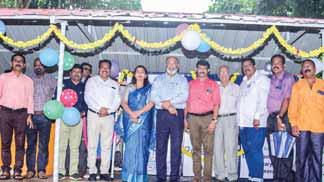
PDG Gaurish Dhond inaugurated a water recycling unit costing Rs 14 lakh set up by RC Honavar, RID 3170, at the government hospital in Honavar. AG Nagaraj Joshi, club president Manvel Stephen Rodrigues, secretary Mahesh Kalyanpur, project coordinator Suryakanth Sarang and Dr Rajesh Kini, medical officer of the hospital, were present.
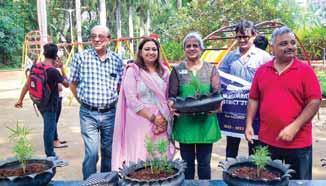
Club president Pushpa Suryamurty with club members arranging the recycled tyre pots at a garden in Mumbai.
Members of RC Mumbai North Island, RID 3141, upcycled old tyres into planters. “The idea was to transform the tyres into environment-friendly usable items as they are built to last and don’t easily degrade. We began with 25 planters and planted the recycled tyre pots in a public garden,” said club president Pushpa Suryamurty.


Rao
Between poetry and music, fiction and nonfiction, the whole world is encompassed.
Every once in a while, comes time to revisit shelves overflowing with books, some read, mostly unread, purchased for various reasons: because the jacket looked inviting, because this is just the author I’m looking for, because it is highly recommended, and sometimes just on the whim of a mood on a particular day. Whatever the reason, the wheel invariably comes full circle and amid much heartbreak you choose what to keep and what not to keep. Some choices are easy to make. Many carry stories and memories on their backs and within their pages. Anyhow, to cut to the chase: that’s what I’ve been doing these last few weeks, clearing out my personal library and, in the process, unearthing some priceless
reading material. The last-mentioned is the perfect new year gift for bookworms like us!

Among the books I recovered with a leap of the heart is a collection of abhangs, devotional songs in Marathi, written by women, and translated into English as The Ant Who Swallowed the Sun. The best part is that it has text in Marathi, a romanised transliteration, with translations in English by Neela Bhagwat and Jerry Pinto. Incidentally, the title refers to the song composed by Muktabai which begins, ‘Mungi udaali akaashi’. As is explained in the preface: ‘…I saw Muktabai as a little girl delicately picking up a black ant, closing one eye and watching as its thin black figure eclipsed the sun. Yes, it is a miracle of perspective. The very small can eclipse the inhumanly large…’ Such profundity in a simple observation — this is poetry!
The second treasure comes camouflaged by a banal title: The Land I Dream Of by Manisha Sobhrajani. As happens often, it was the tagline that was magnetic: The Story of Kashmir’s Women, clearly, voices crying to be heard. In a detailed introduction, the author lucidly lays out the context for the book. If at one time we harboured one kind of stereotypical image of Kashmir and Kashmiris, now, another kind of stereotyping
prevails. The bubble burst for her, the author says, on her very first visit to the region in 2003, when she saw how the tug-of-war between India and Pakistan affected people: ‘For the women of Kashmir, the impact of this political tragedy has been doubly fatal; they have not just borne the wrath of the conflict, but they have also been treated as objects of use and amusement, both by militants as well as by Indian security forces. Azaadi (freedom) — both personal as well as political — has remained a distant dream.’

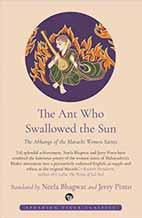
The third book is a recent purchase, published in 2022, that recommended itself thanks to its intriguing title —The Man Who Sold Air in the Holy Land by Omer Friedlander — and the fact that the short stories it contained concern people engendered by the long-entrenched Israeli-Palestinian conflict. The Jewish question, like the Kashmiri question now, has always been a subject of interest. The fact that so many have written variously on it has made it possible to explore it consistently over the years, beginning with The Diary of a Young Girl by Anne Frank which I read as an 11- or 12-year-old. On the very first page of the very first story, ‘Jaffa Oranges’, the narrator quotes a poem: ‘I’m always reminded of a poem by Yehuda Amichai when I think of my children and my grandchildren. It’s called “Eyes”, and I know it by heart. My eldest son’s
Baraye by Shervin Hajipur is a song for freedom to live a normal, ordinary life. He created the song in the wake of the death of Mahsa Amin, arrested for not wearing the hijab properly.

eyes are like black figs for he was born at the end of the summer. And my youngest son’s eyes are clear like orange slices, for he was born in their season. And the eyes of my little daughter are round like the first grapes. And all are sweet in my worry. And the eyes of the Lord roam the earth and my eyes are always looking round my house. God’s in the eye business and the fruit business. I’m in the worry business.’
As I read one book, then the other, and the other, sometimes in between each other, it seemed as though there was a pattern emerging, a pattern of links and connections and similarities, a design that appeared to represent the notion of universality. I didn’t pay much heed to this pattern, apart from acknowledging it casually. And then I heard a song.
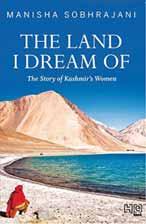
‘Baraye’ has gone viral on social media. It was performed and uploaded on YouTube by a young Iranian musician called Shervin Hajipour. He did it in the wake of the death of teenager Mahsa Amin in Tehran, arrested for not wearing the hijab properly. Hajipour was instantly snatched away by the Iranian authorities and the song was banned
in Iran. He was subsequently released but listeners all over the world continue to listen to his plaintive cries of ‘Baraye azadi, azadi, azadi’… For freedom, freedom, freedom… It’s a simple song, a lament about everyday things such as dancing in the street, peace, the sun after a long dark night, air pollution, changing rotten minds, the shame of poverty, innocent dogs, the future of students, never-ending tears, smiling faces, Afghan kids, a girl who wished she was a boy… All we yearn for, Hajipour sings, is the freedom to live a normal, ordinary life, ‘Baraye hasrat-e yek zendegi-ye mamuli’. The song ends with an anthem-like call: ‘Baraye zan, zendegi, azadi, baraye azadi, baraye azadi, baraye azadi…’; for women, life, freedom, for freedom, for freedom, for freedom.

‘Bella Ciao’ which began as a protest against the hardships of working in rice fields under cruel overseers and became an anti-oppression anthem. It even has a Punjabi version, but the story around the Turkish version, called ‘Bella Chav’ is fascinating. Of course, it was banned by the authorities. Two members of the band, Grup Yorum, that sang the song protested the ban by going on hunger strike; both died. A few days after the second death, ‘a curious incident happened in Izmir, a Turkish city.
Instead of the regular azaan, or call for prayer, Grup Yorum’s version of “Bella Ciao” was played from several minarets of mosques across Izmir. A woman was later arrested for orchestrating this protest.’ The last line of the song, ‘Muerta per la Libertad’ means ‘to die for liberty’.
Somehow, in a strange, mysterious, serendipitous way, the song seemed to encapsulate all that these books were saying, about life, about desire, about oppression, about dreams, about hope, about faith, about the human condition. That’s what all expressions of art are, aren’t they, whether they are images or stories or paintings or films or songs…
Just when I was ruminating over all this, Gopi our magazine-wala dropped off Frontline magazine. In it was an article called ‘Do you hear the people sing?’ by Vijayta Mahendru. About ‘Baraye’! And lots more people’s songs, such as the Italian
Closer home there’s ‘Hum dekhenge’, a poem written by Faiz Ahmed Faiz in 1979 when Zulfikar Ali Bhutto, former prime minister of Pakistan, was jailed, and eventually hanged, by the Zia ul-Haq dispensation. It was also, apparently, written in protest against Iran’s dictatorial monarchy. In 1996, the well-known Pakistani ghazal singer Iqbal Bano performed it to a packed audience, wearing sari, in an expression of double defiance — performing a protest song and defying the sari ban. It continues to be sung at protest rallies in India. Do you hear the words that connect us all?
The columnist is a children’s writer and senior journalist.
Designed by Krishnapratheesh S
The city of Salem wore a festive look as Rotarians from RC Salem Phoenix, RID 2982, in partnership with the Salem City Police, organised a grand marathon against drug abuse, in which 2,000 persons, including children from three years onwards, and elderly persons, participated.
The event saw keen participation from police officers including Salem city police commissioner Najmul Hoda. “We were overwhelmed by the response we got; young children had assembled at the venue, Salem Gandhi Stadium from 5am, and while the event, which was divided into different categories, had 2,000
participants, it was watched by around 4,000 people,” said event chair and club member Hemnath. “At the end of the day, it was not only an effective way to raise awareness against drug abuse, but also boost the public image of Rotary, and show how it works for the welfare of people in the community,” he added.
The marathon included shorter run of 2km for children below 12 years, 5km and 10km runs for women and men respectively. Each participant was given a medal and a certificate. Trophies and cash prizes were given to the top three winners in each category.
Police commissioner Najmul Hoda, addressing the gathering as
chief guest, complimented Rotary for working for the welfare of the community through various projects and recalled the vital assistance given by Rotarians to the administration during the Covid pandemic. He spoke on the evils caused by drug abuse and thanked Rotary for taking up this cause. District governor P Saravanan, deputy commissioners of police SP Lavanya, M Madasamy and S Radhakrishnanan participated.
Club president J Kesavan said the club’s objective in organising this run against drugs was to raise awareness against drug abuse and “ensure that our mission that Salem remains a clean, drug-free city is accomplished.”
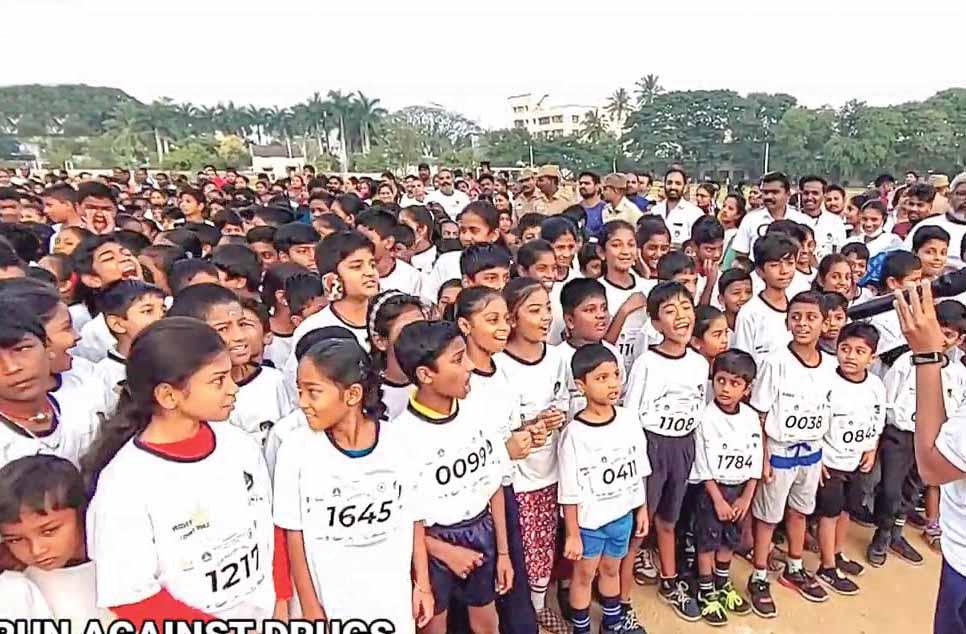

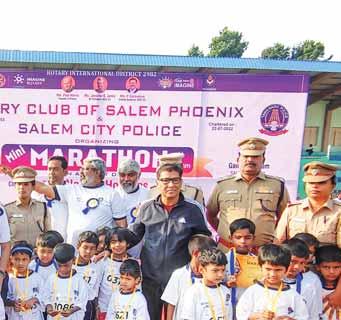

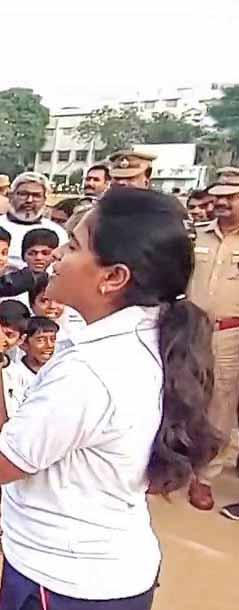

Above: Salem city police commissioner Najmul Hoda (fourth from R) and RC Salem Phoenix president J Kesavan (third from L) with the participants.
Left: Young participants all set to run the marathon.
Below: Participants taking a selfie after the marathon.
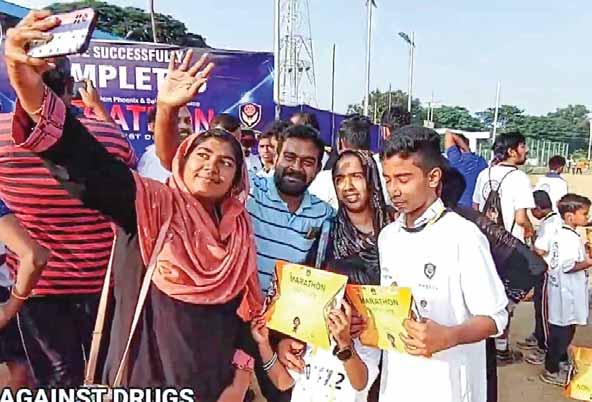

Preeti Mehra
Here is a bunch of planet-friendly resolutions to make you feel good in the New Year.
They say it is best to take one step at a time to reach a goal. And if your goal is to make the planet a better place, it is best to start 2023 with green resolutions and commitments. Promises to keep rather than make and forget.
Resolutions can be personal as well as social — both good for you and for your family. These small actions you initiate will translate into being beneficial for the community, the country, and the world at large.
It is best if your resolutions are simple and effective. Here is an easy-to-do list that will assist you in sustainable living.
Resolve never to use plastic bags that litter our cities and forests, clog our storm drains, and pollute our
rivers and oceans. This is not an easy task. It is natural to forget to carry a reusable bag each time you go out shopping. To help you remember, it is best to stitch or invest in several cloth bags — one hung near the main door so that you can grab it when venturing out. Another one can be kept in your vehicle or in your office drawer. These days you get reusable bags that are are small enough to fit into your pocket.
Resolve to use public transport as much as possible rather than wasting precious fossil fuel on your private vehicle. Again, this is difficult when it is so convenient to get into your own vehicle. But by making this choice you will not only be saving fuel but contributing to improving air quality. Human beings inhale around 14,000
litres of air every day and if it is polluted, it badly impacts their health and leads to respiratory diseases. Air quality also affects the country’s economy as it results in high medical costs, loss of productivity due to illness and high infant mortality.
Bad air impacts the environment adversely as pollutants settle on the land and water bodies. Some pollutants are responsible for climate extremes as they have a warming or a cooling effect.
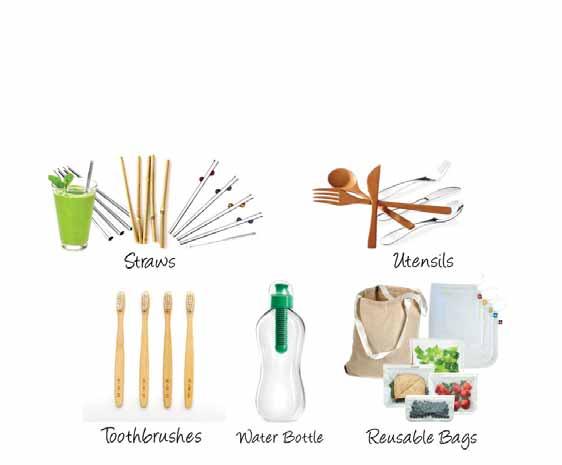
Resolve to buy less clothes, especially fast fashion garments that are inexpensive but are discarded in no time. According to estimates, 57 per cent of discarded clothing end up in landfills. And when these get full, they are incinerated as waste. Synthetic clothing creates the worst impact as 35 per cent of all microplastics that pollute the oceans come from these clothes. The fashion industry consumes one-tenth of the water used by all other industries. This is because production and dyeing of clothes use massive amount of water and toxic chemicals. Experts estimate that producing one kg of cotton requires 10,000 litres of water and 20 per cent of wastewater in the world is attributed to the dyeing process.
Resolve to use less energy in everything you do. Put off lights, fans, air-conditioners when you leave a room. If you are using a washing machine, make sure you collect the
entire household’s clothes for its optimum use. Install solar lights and a solar system for heating. It would be great if you could switch to cooking at least one dish in a solar cooker and plan your meals such that you cook at one go for two or three meals, saving precious natural reserves.
Resolve to buy local and eat organic. Your local vendor will fetch vegetables and fruits from the closest source, which means less energy spent. Besides, you are contributing to the livelihood of a micro-entrepreneur. Organic food ensures that the environment is subjected to less soil pollution, soil erosion and energy. You also get to eat pesticide-free fresh food.
Resolve to segregate your waste and compost your wet waste. This would be a big step in helping our landfills from being overpowered with unsegregated waste that leaches into the ground and causes toxic emissions. Unprocessed waste gives rise to a host of diseases that impact humans, animals and plant life.
Resolve to travel less and only when it is required. Travelling involves consuming a massive amount of energy. Flying is especially bad for the environment and leaves a massive carbon footprint. It also contributes to global warming and pollution as airplanes use fuel that releases carbon
dioxide and pollutants into the atmosphere.
Be a consumer who advocates for climate-friendly products that promote a circular economy. When companies come to know that consumers will not buy products that pollute the earth and are unhealthy for humans, animals and plants, they will shift to providing better products. And when they know that you are watching if their product closes the environment loop, they will design and sell more ethically.


Resolve to recycle and upcycle all that you use. For instance, if you get your gadgets fixed instead of discarding them, mend your garments instead of throwing them away, and put your old things to new productive use, you would be saving water, energy and your hard-earned money.
Last but not the least— resolve to track your carbon footprint. When you see it reducing before your eyes, it is a true feel-good moment. There are lots of apps just a Google away that can help you do that.


Now that you have a whole lot of resolutions to choose from, here’s to a happy and ecofriendly 2023!
The writer is a senior journalist who writes on environmental issues
Designed by N Krishnamurthy



Smart skills are being imparted to teachers and students of St Mary’s Hindi Medium School, Bistupur, by RC Jamshedpur Midtown, RID 3250, to make them future-ready, equipped with the right mindset to take on the emerging challenges in classroom education.
Designed by Rtns Preeti Saini and Shiva Rao, past president (2021–22) over a casual talk during Diwali last year, the TEACH programme was launched on Jan 30, 2022. Teachers are trained through interactive lectures, group activities and live classes in their schools to give them a “practical idea of how to conduct classes based on experiential learning,” said Preeti. The programme covers soft skills including presentation, leadership, communication, interpersonal, spoken English and IT skills. So far, 25 sessions were held at the school with five teachers and 200 students in each class.
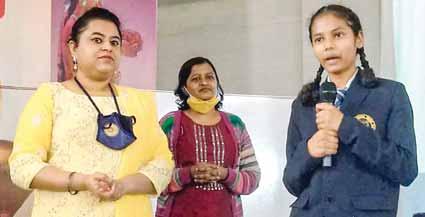
All the classes were taken by project director Preeti with support from Rtns Ekta Agarwal and Sumedha Gautam. “The activities part of smart skills is the major highlight as students get a chance to implement what they have learnt, enabling a smooth assimilation,” said Preeti. Around 290
students from Classes 9 and10 have benefitted from the programme. The project also involves parents for holistic growth of students. School principal Prem Lata has been a pillar of support for the Rotarians who are keen to expand the smart skills project to other schools.
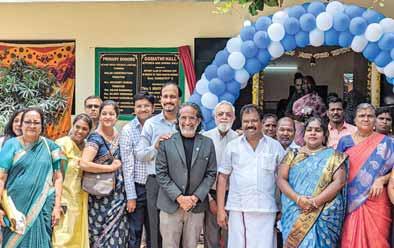
RC Chennai ECR, RID 3232, adopted the Kudumiyandithoppu Elementary School (KES) in Panaiyur, a village near Chennai, in Sept 2019, to provide it with better infrastructure. After refurbishing the toilets in 2020, the club recently renovated the kitchen and constructed a 785 sqft dining hall, naming it ‘Gomathy Hall’ after the club’s charter member. The new facilities worth `11 lakh were inaugurated by DG N Nandakumar in the presence of MLA Aravindramesh and councillor Menaka Shankar.
“We want to enhance the school’s facilities to increase the student strength to 750 students in the next five years,” said the club’s past president Deepak Sanghi who is coordinating the project, along with club members Ajit Nair and C S Ananth.

It was a huge knock by 26-yearold Narayan Jagadeesan for his Team Tamil Nadu, playing with minnows Arunachal Pradesh at the Vijay Hazare Trophy cricket match, 50 overs a side, one-day format, in Bengaluru recently. It brought this lanky, wicket-keeper batsman into the spotlight of world cricket. His father, Rtn CJ Narayanan from RC Coimbatore Metropolis, RID 3201, has one constant advice for his son: “Keep up the concentration to earn the blue jersey.”
During his power-packed innings, Jagadeesan broke seven world records in List-A cricket — highest individual score (277); consecutive five tons; fastest 200 runs in 114 balls; fastest 250 runs; highest partnership for any wicket (416); highest opening partnership; and highest team total of 502. Next day, the national dailies went gaga

V Muthukumaran
over the triumph of this Coimbatore lad. His parents, Narayanan and Ganga, are optimistic that their son is on the way to finding a place in the national team. “He is capable of many such splendid performances,” says his father. Having played for Tata Electric Company, now Tata Power, in Mumbai for eight years from 1980, Narayanan is well aware of the rigours of modern-day cricket, especially the T20 format that frustrates even the toughest player in world cricket. Jagadeesan started playing cricket at the age of four at the Stanes Anglo Indian HS School; and represented the district Under-13 at nine. “After completing BCom at PSG College six years ago, he did MBA at Sri Ramakrishna College. Throughout his academic journey, he played cricket with a rare passion, and made his first-class debut for Tamil Nadu in the Ranji Trophy match
against Madhya Pradesh in 2016–17,” recalls his father. And got a maiden ton in his debut match, to boot!
His mother Ganga and sister Sharada can’t wait to see him perform for Team India. “With prayers on their lips, they look forward to him batting for the country. God willing, my son will climb up the ladder,” smiles Narayanan, who joined Rotary in 2007. While he is not worried that Chennai Super Kings has released his son, “I am confident that he will be picked up by a good team in the IPL auction.” RCs Coimbatore Metropolis and Coimbatore Manchester honoured the player with Young Achiever Awards. Earlier, he was felicitated at the RID 3201 conference.

“My only aim now is to live the present without thinking about the future and enjoy playing cricket,” quips Jagadeesan.
Rtn C J Narayanan (centre) with (from L) his son Narayan Jagadeesan, wife Ganga, daughter Sharada and her husband Kirthi Krishnan.
My only aim now is to live the present without thinking about the future and enjoy playing cricket.
Narayan
Jagadeesan Tamil Nadu cricketer
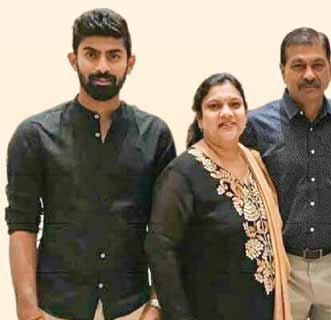

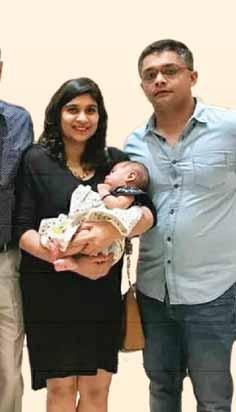
Bharat and Shalan Savur
Idrank half a glass of water before writing this article. For, a thirsty brain does not work efficiently enough. A hydrated brain sits up, all alert, ready with words and all the skills it possesses. Ditto with a hydrated body. It gets set to stave off all illnesses and… bloom with health. And the mind? Nothing seems too much, when your brain is well hydrated. It peps up.
No exaggeration, that’s the great effectiveness of water. A humble fluid yet a fantastic health enhancer and lifesaver. Never undermine it just because it’s there everywhere, literally. Understand its immense value, why it has been made abundantly available ever since the world came into existence. It is one of the best supplements and medicines you can lay your hands on. It’s not just a necessity, but like air, it’s a super necessity. Have a few sips as you read this article and keep sipping, dear friends. I’d love to feel that you and I are together flowing in this lovely river of health and well-being…
The best breakfast ever
To be in mint condition, the body needs to maintain its 70 per cent water composition. The water keeps the body at the right temperature so that it doesn’t overheat and cause health problems. Take the first sip in the morning. After you’ve brushed your teeth, enjoy two glasses of water. And then have coffee or tea. Water is the best breakfast in the world, and an ideal way to break a fast. Those who fast formally are advised to break their fast with a glass of water before they eat. And don’t we all go on an allnight fast when we sleep?
With meals, keep sipping water or, if you want a change, go for thin buttermilk. It helps the food slide smoothly down your throat. It’s a great digestive ally. Some people feel tired after they’ve eaten. That is because the body uses up loads of energy to digest, more energy than it can handle when it is not in its optimum condition. A glass of water or two during a meal hydrates and banishes tiredness.
When you drink a litre of water in a day, you will feel pretty good. When you drink two litres, you will feel extraordinarily better, more fit, more cheerful. So, don’t let the water level fall. Keep your inner monsoon going. Every time you go to the bathroom, come out and head for the water bottle. When you perspire even a little, have a few sips.
My thumb rule is: Drink a lot when you’re thirsty, drink a little when you’re not. When you keep sipping,
you’ll be surprised how thirsty you feel as if the body is enjoying it and saying, ‘Give me more.’ Even before or after your afternoon tea, please have some water. It’s a good practice. The benefits far outweigh the slight inconvenience of running to the bathroom more often:
Water beats constipation, promotes easy elimination without strain.
Eases digestion as it breaks down the food and washes off excess sodium which means the blood pressure stays balanced. It softens fibre in the food and prevents the bloated feeling.
Boosts kidney health as it dilutes minerals and salts that can later become stones. Well-irrigated kidneys are whizkids in balancing blood pressure, filtering waste and even maintaining the body’s vital 70 per cent water level. Makes your skin plump up and minimises wrinkles. Flushes

out toxins and leaves the skin radiantly youthful. Keeps your walk or workout cramp-free. Two cups of water before training are recommended. If you stretch your legs at night while asleep and your calves cramp painfully and wake you up, it’s because the dehydrated muscles are asking for water. Water is the champ of cramp-busting any time. Lifts your mood. Dehydration stresses the body, hydration peps it up. Drinking water through the day takes care of exhaustion, low moods, negative thoughts, anger or frustration.
Clears your mind. Lack of water causes confusion and disorientation. Adequate water re-orients: you feel more yourself. Helps the immune system. How? The immune system needs its daily dose of H2O to produce lymph which helps wash out toxins and keeps the body in prime health. Often, when the body organs are dehydrated, they work slowly and listlessly and you feel
fatigued and weak. Drink to feel energised. Flushes out toxins. Your body does its job. Its lungs, kidneys, liver work hard to detox. They rely on water. Give it to them. When a person is recovering from a serious illness and is on strong medicines, the doctor prescribes four litres of water daily. Why? In order to help the lungs, kidneys, liver throw out the rubbish and keep the system clean and working and healing smoothly. So, please don’t take it lightly. Drink up. Boosts brain performance. Studies show that being dehydrated by just two per cent lowers motor, memory and cognition skills. It beats caffeine.
Prevents headaches. Medical News Today calls it a dehydration headache which comes on when the body loses essential fluids. Along with the rest of the body, the brain too gets dehydrated and this makes it shrink. This shrinking becomes a painful contraction. So, if you’re prone to headaches, please keep the sips on to replenish the seepage of fluids.

Boon for the heart. Ah yes, it helps keep the heart hale and hearty. Doctors say water regulates the viscosity of blood and plasma. It thins the blood and reduces the risk of a heart attack or stroke.
Avoid overhydration
Yet, for all that, too much water in the system is as bad as too little. And nothing brings it home more poignantly than the latest findings on the martial art legend Bruce Lee who died at 32 half a century ago. After a recent review of the evidence, with new
advances, a team of experts says in the Clinical Kidney Journal , “We propose that the kidney’s inability to excrete excess water killed Bruce Lee.” Overhydration or hyponatremia is bad because it washes out precious electrolytes such as sodium from the body and can cause confusion, nausea, disorientation and, in rare cases, even death. So, how much is too much? Experts say that a healthy kidney can eliminate about 27–34 ounces per hour or 676–947 ounces per day, that is, a total of 20–28 litres per day. That’s huge! Since no one can put away such copious quantities, why should overhydration occur at all? Malfunctioning kidneys, regular intake of non-steroidal anti-inflammatory drugs, uncontrolled diabetes, or a blockage in the urinary tract could make the body retain waste fluids. That’s why, if the body suddenly stops passing urine, it is time to consult a doctor.
So how much is safe?According to doctors, we need one litre of water for every 20kg of body weight. So, if your body weighs 60kg, you need about three litres a day. And you can include in your calculations, tea, coffee, sodas, fruit juices, vegetable soups, even sauces. A special mention here for those who may be on a low-salt diet due to high blood pressure — please do not overhydrate. Check with your doctor about how many glasses are safe for you. Exercisers need to keep Electral sachets or tetra packs handy to be chugged when they perspire too much.
Ultimately, go by your level of comfort. Don’t force yourself to drink through gritted teeth and don’t ignore your thirst. Learn how much keeps you feeling healthy, fresh and all there. As Epictetus said, ‘Only the educated are free.’
The writers are authors of Fitness for Life and Simply Spiritual – You Are Naturally Divine and teachers of the Fitness for Life programme
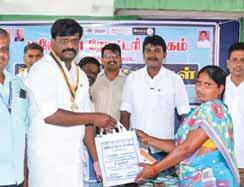
Kits containing nutritious edibles to last for a month were given to 40 TB patients to enable them consume healthy food.
A dialysis centre (`28 lakh) with three machines was inaugurated by DG Anand Jhunjhunuwala at the Chhatrapati Shahu Maharaj Hospital, Jalgaon. RC Tallahassee, RID 6940, US, was the GG partner.

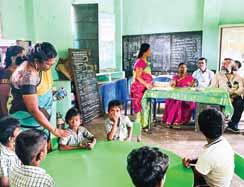
Furniture worth `30,000 were donated to a panchayat union middle school. Club president Vanchinathan led the project.
Over 2,200 people ran the half marathon co-sponsored by the club and organised by Shree Ram Swimming Club. Rtns Harshit Rughani and Deepak Unadkat were the chief architects.
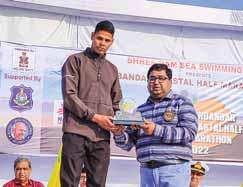
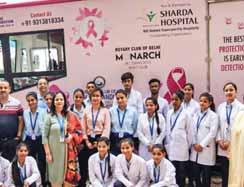
Twenty women were examined at a mammography camp held at Nangal village with the help of Sharda Hospital, Noida.
Bhajan Kaur (69) from Jalandhar was operated successfully for corneal blindness under Project Gift of Sight.
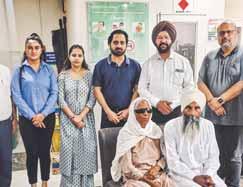
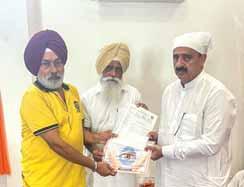
Late Mohinder Kaur’s eyes were donated to PDGI Hospital, Chandigarh, which were transplanted to two visuallyimpaired people. Rtn Harpreet Singh Rekhi is promoting eye donation in a big way.
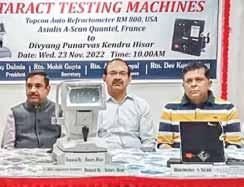
Two cataract testing machines (`9 lakh) were installed at the Divyang Punaravas Kendra, Hisar. Eye screening and cataract operations for needy patients will be done free of cost for a year.
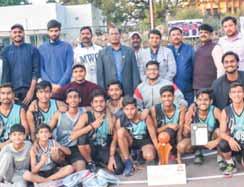
DGE Ashok Gupta and MP Rajendra Agarwal inaugurated a two-day Inter-School Basketball Championship. Out of 14 schools, St Thomas School won the finals bagging the trophy and cash prize of `21,000.
Agra SP Vikas Kumar was the guest speaker at a workshop on cybercrime at the Baikunthi Devi Kanya Mahavidyalaya. Club president Mrinal Sharma honoured the speaker.
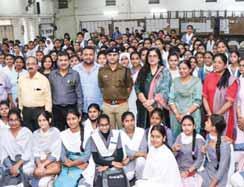
Over 700 people including students were examined at a mega health camp held jointly with All India Madhya Pradesh Vaish Sabha at Nav Yug Vidya Mandir Inter College.
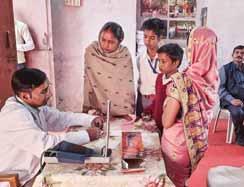
DG Anil Parmar donated five oxygen concentrators and accessories to the Panvel Corporation to be used by the UPHCs. PDG Girish Gune and civic body commissioner Ganesh Deshmukh were present.
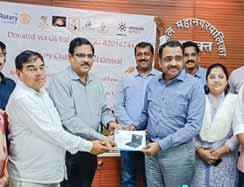
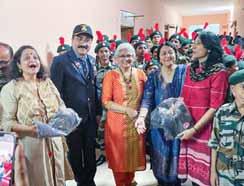
Past president Padma Kapoor donated sports uniforms to 400 students at the Vijay Army School, Chikhale, in memory of her father late Major Desai.
Ten water purifiers worth `1.5 lakh were distribute to rural government schools to provide safe drinking water to students and teachers.
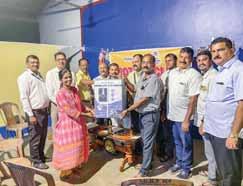
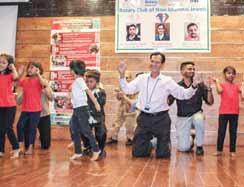
A children’s party was held for the inmates of Sparsha Charitable Trust at SIES College of Management Studies, Nerul.
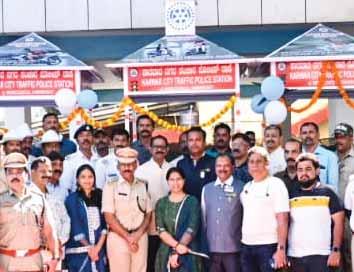
Stainless steel police booths were installed at traffic circles in Karwar with Rotary banner and logo on all sides. Two wheel chairs were donated to mark World Polio Day.
Blankets were distributed to 300 conservancy workers in Tumkur to protect them from wintery nights. The event lifted the public image of Rotary.
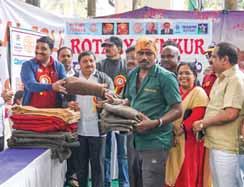
Project Milky Way is delivering 300 litres of milk every month to the Desire Society, a home for orphans and HIV positive children at Vashi branch, Navi Mumbai.
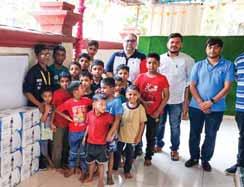
RC Ootacamund — RID 3203RC Chennai Port City — RID 3232
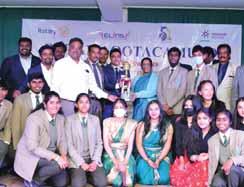
More than 350 students from 25 schools took part in a Talent Hunt at the JSS Public School. DG Elangkumaran and additional SP, Nilgiris, Mohan Navas were chief guests.
The club, along with RC Tambaram Central, distributed rice bags and bedsheets to 50 differentlyabled in the presence of chief guest PDG Raja Seenivasan. Three tricycles were donated.
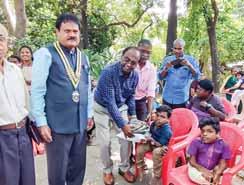
RC Alleppey Greater — RID 3211RC Bokaro Steel City — RID 3250
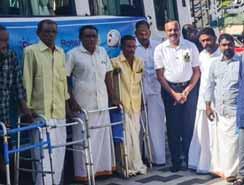
Crutches and walkers were donated to 50 leg amputees at a special camp conducted with the help of the Indian Coast Guard. AG Gireesan KG inaugurated the project.
More than 100 students were tutored on leadership skills at a 3-day RYLA inaugurated by principal district judge Ranjana Asthana. Club president Nirupama Singh and district RYLA chair PDG Anil Kumar were present.

RC Tuticorin Trailblazers — RID 3212RC Jagdalpur — RID 3261
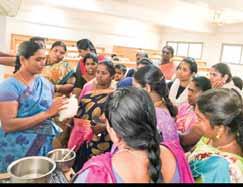
An entrepreneur training programme was held at the Annamalai College of Education. Thirty participants were taught to make detergents, soap and cultivate mushroom.
An artificial limb fitment camp was held jointly with RC Jamnagar and Helping Hand, an NGO. Project chair Sanjay Bathwal coordinated the event.
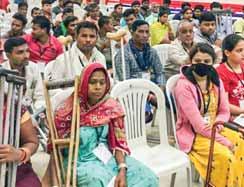
Compiled by V Muthukumaran
Four decades ago, I won a journalism fellowship at the Cambridge University in the UK. It was for just three months, for what they call the Michaelmas Term there. The college was Wolfson and it had a couple of Pakistani civil servants too. They were from the Pakistani equivalent of our own IAS. My wife and I arrived there at the end of September and by the first week of October the two Pakistanis of our age and we had struck up a nice friendship. One of them was a Pathan and a devout Muslim but the other one was less fussy.
Both of them were starved for South Asian food. So once in a while they’d land up with some chicken or mutton and ask my wife to make something ‘Indian’ — which she did with the help of a curry paste called Pathak’s paste. They’d also bring the naans and the salad leaves, grapes, apples, plums and pears, not to mention some wine too.
Once I asked them why they spent so much on the food and offered to pay our share but they refused to take the money. “It’s better than eating a toadin-the-hole,” they said. The toad was the weekend dish in the dining room and truly horrible. It consisted of a sausage in thick, fat-soaked batter made of flour. It was so heavy on the stomach that even in my early 30s I couldn’t finish it. So whenever this ghastly dish was on offer, the Pakistanis would turn
up. Soon some Indians also started coming whenever the toad was on offer. They brought desserts and so on. It was great fun.
But in mid-November my wife returned to India leaving us to the mercies of the toad. The Pakistanis were most unhappy till, in late November, one of them came up with a brilliant idea. There was a Punjabi lady running a shop where she sold samosas and other South Asian pastes and masalas, snacks and sweets. She once told my wife to find a girl for her son just like her. My wife was so pleased that the lady tripled her sales to us.
Anyway, the Pakistanis and I went to her and asked if she would prepare some dal-roti for us on the toad days. She very kindly agreed, little knowing that dal-roti in Pakistan meant mutton

in the dal, and chicken as a side dish. But she cooked everything without complaining. We compensated her well.
Thus the rest of that term passed off in relative contentment. In fact, far from dreading the toad, we actually started looking forward to it. It was, if you like, our version of a response to Marie Antoinette asking the people to eat cake if there was no bread.
The old British universities also have this tradition of weekly dinners for ‘Members’, meaning teaching staff. Plenty of sherry and port were supplied at these dinners. I was a permanent invitee, as was my wife. But the Pakistanis weren’t. That annoyed them hugely because they were ‘members’ of an elite Pakistani service and I was just a lowly journalist. They never got used to the idea of exclusion from those weekly dinners.
To escape the toad-inthe-hole, the Pakistanis would land up with some chicken or mutton and ask my wife to make something ‘Indian’.
When the Pathan asked me why this was so, I told him jokingly in Punjabi that the dinners were for shareef (civilised) people. He didn’t speak to me till the next time he had to ask my wife to cook. Even then he was in a sulk and I don’t think he would have forgiven the Brits.
All good things must end and I came back to India at the end of the term. The Pakistanis were there for two more terms. I wonder how they fared. Nice guys stuck with the weekend toad because as luck would have it, the samosa lady also left in December to look for a nice girl for her son.
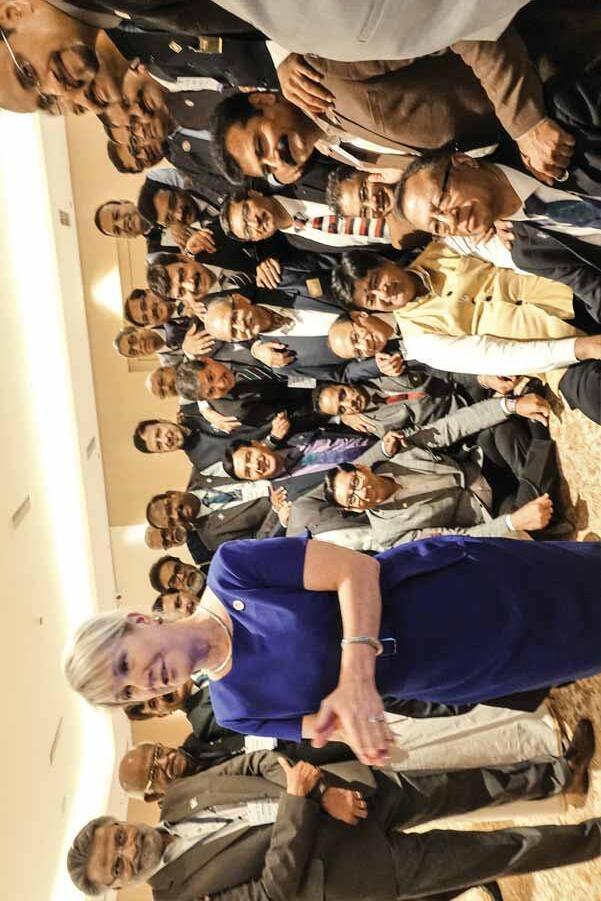
Registered No. TN/CCN/360/2021-2023
Licensed to post WPP No.TN/PMG(CCR)/WPP 431/21-23
Total number of pages in this monthly issue, including cover, 84. Price: `40
Registered with Registrar of News Papers for India 3880/57 Rotary News Published on the first week of every month


... with a circulation of 1.45 lakh, and connect with 6 lakh readers. Reach some of the most influential industrialists, businessmen, finance professionals, doctors, lawyers and other high flyers.
